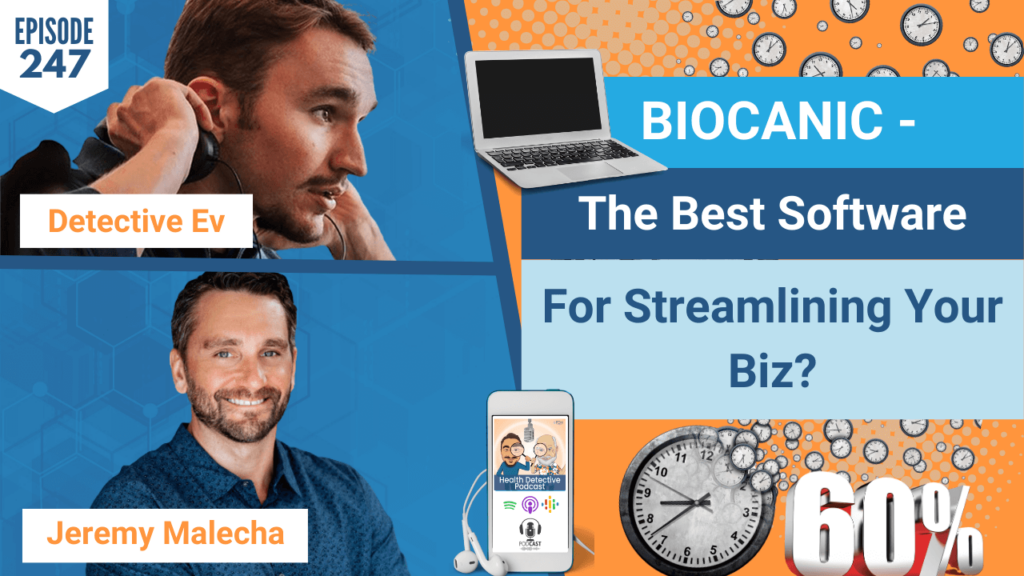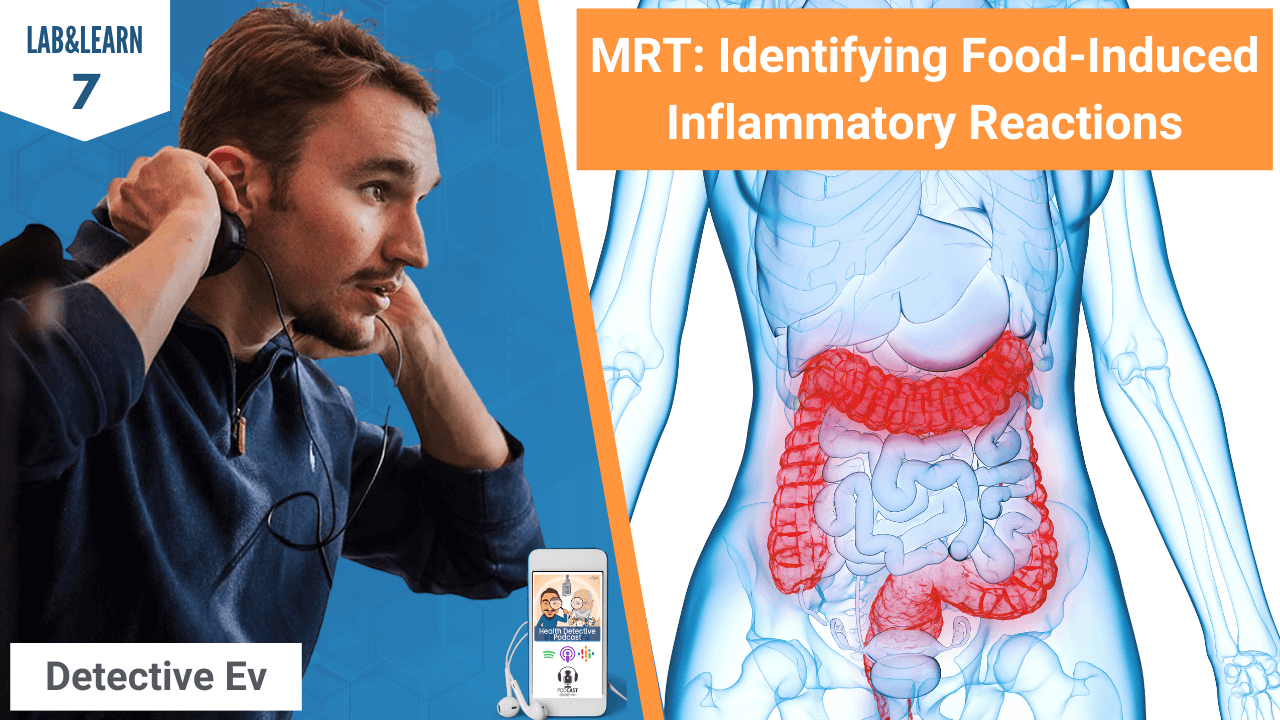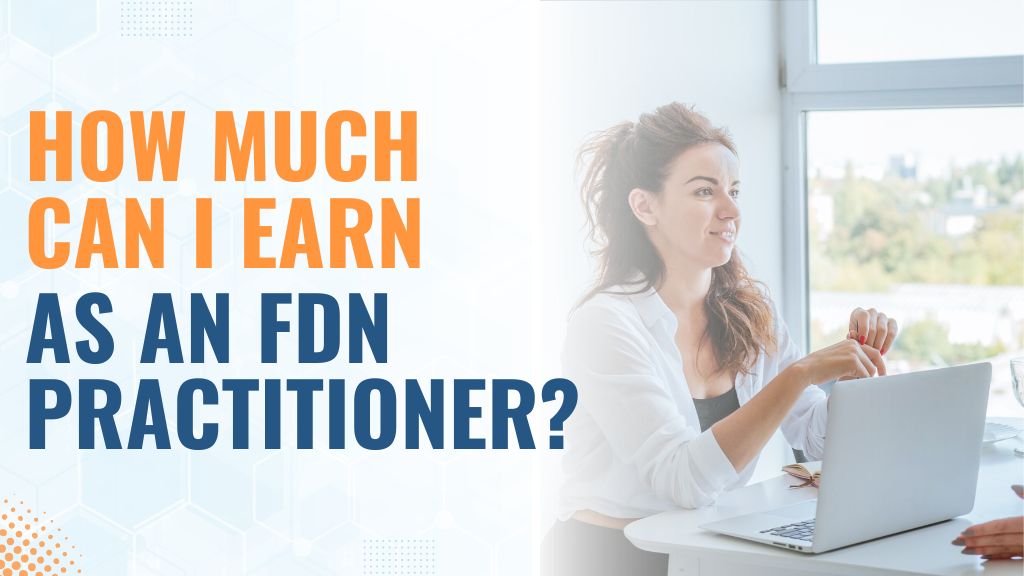Introduction
[00:00:00] Detective Ev: What is going on, my friends? Welcome back to another episode of the Health Detective Podcast by Functional Diagnostic Nutrition. My name is Evan Transue, aka Detective Ev. I will be your host for today’s show all about Biocanic.
We have a pretty interesting guest on. His name is Jeremy Malecha, and his wife is the entire reason that I’m on this podcast right now. What I mean by that is it is his wife that I heard talking in a coffee shop over six years ago now. She was an FDN practitioner talking to, I don’t know, 20 or 30 people about what she offered.
I went up and talked to her and she was nice enough to take me out to lunch, talk to me about FDN, got me on the phone with Reed Davis, the founder of FDN, and we just chatted, man. I ended up signing up like less than a month later and getting involved. It’s been a crazy journey ever since. So many things have aligned to work this out and it’s hilarious to me that I’m doing the podcast now. I just think that’s full circle.
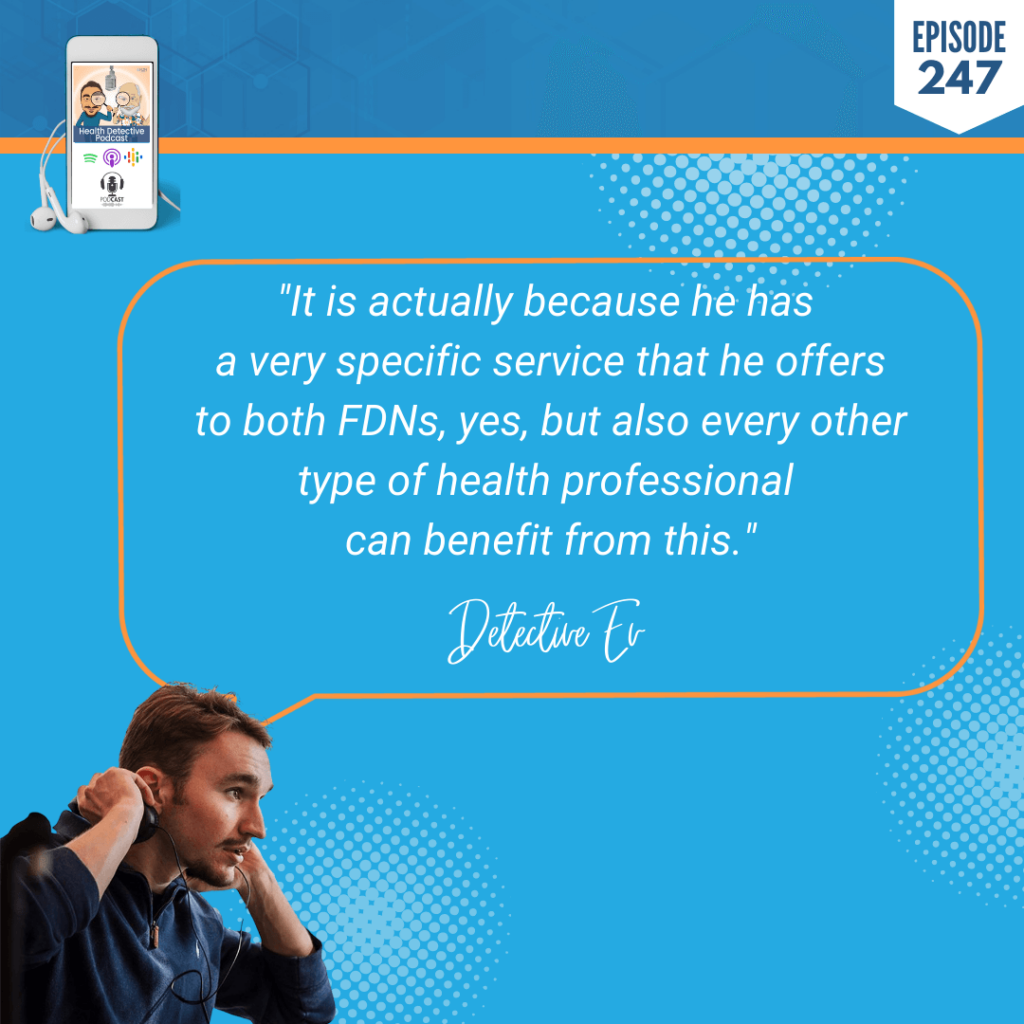
The reason we’re having Jeremy on is not because he is a health coach or anything like that. It is actually because he has a very specific service that he offers to both FDNs, yes, but also every other type of health professional can benefit from this. Here’s his background and then I’ll explain a little bit more of what we’re talking about.
Jeremy’s Background
Jeremy Malecha is CEO and co-founder of Biocanic with over 20 years of healthcare and software-related experience. Prior to Biocanic, he was the Vice President of Strategy and ResMed’s SaaS Business. Across his 10 year plus career at ResMed, he also held senior leadership roles overseeing global product management across the product portfolio and was the lead person behind the conceptualization and launch of the ResMed digital health ecosystem.
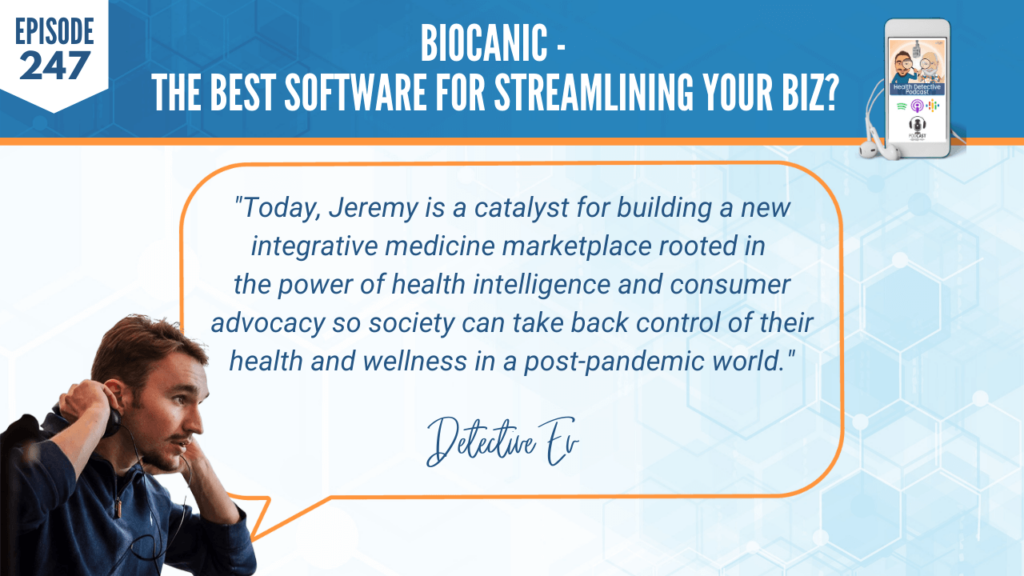
Today, Jeremy is a catalyst for building a new integrative medicine marketplace rooted in the power of health intelligence and consumer advocacy so society can take back control of their health and wellness in a post-pandemic world. He holds a Bachelor of Engineering in Biomedical Engineering from Northwestern University in addition to multiple patents in signal processing for medical applications.
I gotta be honest, I didn’t know Jeremy as well before doing this podcast and getting to see him recently at a conference, they’re just, Jeremy and Jenn that is, two really impressive people. They are two peas in a pod, I will also say that, but fascinating folks, very successful in what they’re doing.
What we’re talking about today, I already kind of mentioned this in the beginning of his bio, is Biocanic. Biocanic is a platform that would be similar, definitely, in my opinion, better, but similar to things like GetHealthy or Practice Better.
Now, what’s really interesting about Biocanic is, remember, Jenn Malecha is a long-term FDN, been doing it for I think almost 10 years, if not over 10 years at this point, and she has worked at high levels in FDN as well. So, she no longer does that, but she’s been a strategic business partner at times, she’s been head of sales at times. So, she knows FDN in and out.
Biocanic: Customized Client Management System
One of the reasons Jeremy created Biocanic was because he saw a need that Jenn was exposing as she was working with more and more health coaches. It’s really, really cool to see all of this come together.
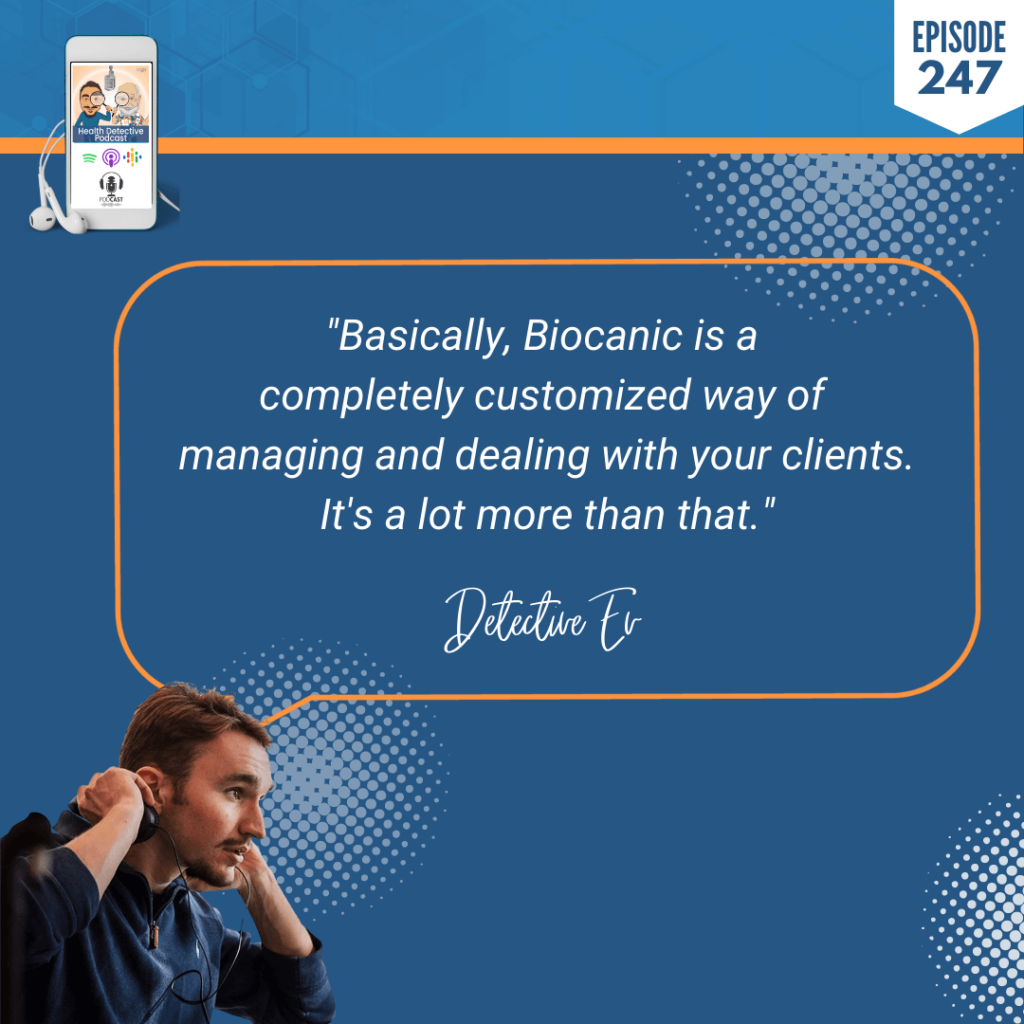
Basically, Biocanic is a completely customized way of managing and dealing with your clients. It’s a lot more than that. I think this is one of those times where I could talk about every little feature and benefit, I’d be doing you a disservice. It’s better to hear about it in the podcast.
And another thing to note is this is one of those ones where we do actually have a YouTube video to go along with this just so you can get a visual. It’s not for the entire time. In fact, it doesn’t even start until I think 14 minutes into the recording itself, and it only goes for like 10- or 15-minutes tops. So, if you want to see the platform and get more of a tour with it, that’s how you could do it. But this is still totally a podcast that could be digested solely through your ears.
I know at my business we’re really excited to get to use this stuff. I had never really looked into these softwares before because I had only been doing, as you guys know, if you’re regular listeners, I had been only taking clients here and there because I was mostly doing public speaking in schools.
Biocanic: Time Saver
And now as I am expanding Bucks County Light Therapy and I have a few FDNs under me that are relying on me to get them clients, I’m realizing I want to make their lives as easy as possible so that they can be in their zone of genius, which is working with the people and helping them get better. And all these tools, all these systems that we have access to, something like Biocanic, we should be using that stuff so that we can focus on being in our zone of genius.
In fact, this is crazy to me. Jeremy even said that he believes this system, once you get this down and once you learn how to use this software, can actually save about 60% of the time that you would normally spend with a client. Now, this doesn’t mean the client’s getting less of a service. In fact, they’re actually probably getting a better one, that’s the best part.
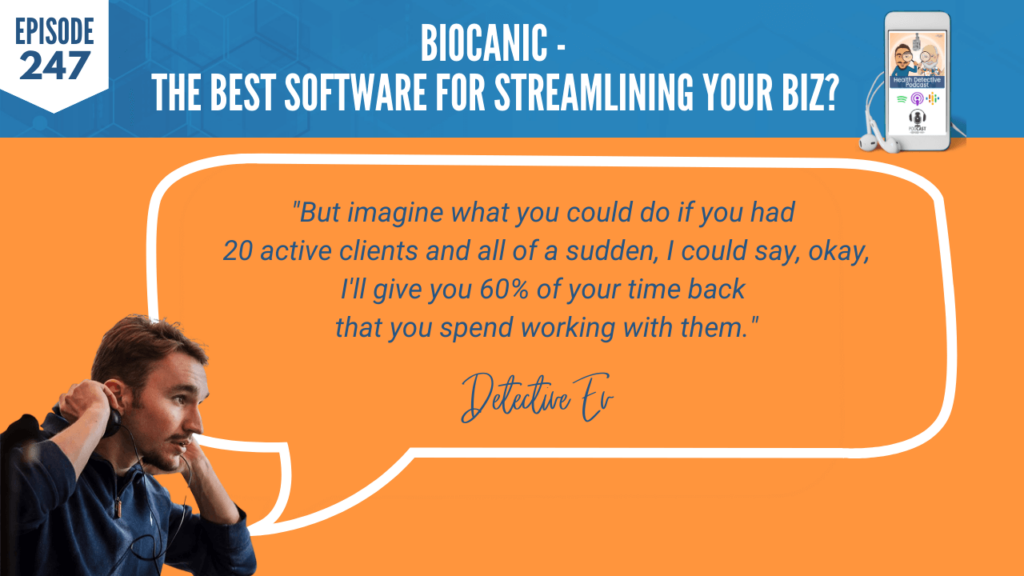
But imagine what you could do if you had 20 active clients and all of a sudden, I could say, okay, I’ll give you 60% of your time back that you spend working with them. Well, wouldn’t that mean that you could then effectively double to 40 clients and really not spend any extra energy? I would say so.
When I said they’re two peas in a pod, it’s so cool to see Jenn and Jeremy come together. Because I’ve always thought of Jenn as this highly systematic, very efficient person. Then you meet Jeremy, and you’re like, oh my goodness. Like these two, where the heck did you find each other? Because they’re perfect for each other. With all that said, I want you guys to enjoy today’s episode. I hope you like this one.
Biocanic: A Different Approach to Practitioner Support
And if you have any questions about Biocanic, we will have where you can reach out to them below. Alternatively, if you have a question for us specifically at FDN, you can always reach out to us at fdntraining on Instagram. Without further ado, let’s get to today’s episode.
All right. Hello there, Jeremy. Welcome to the Health Detective Podcast. How are you?
[00:05:45] Jeremy Malecha: Great. Thanks for having me on. I’m really looking forward to this.
[00:05:48] Detective Ev: Yeah. It’s only fair. I mean, it’s kind of funny. So, just to connect this for people really quick, it is Jeremy’s wife, Jenn Malecha, who was on twice with this show so far. She was like episode five. Jenn is the exact person that actually got me into FDN.
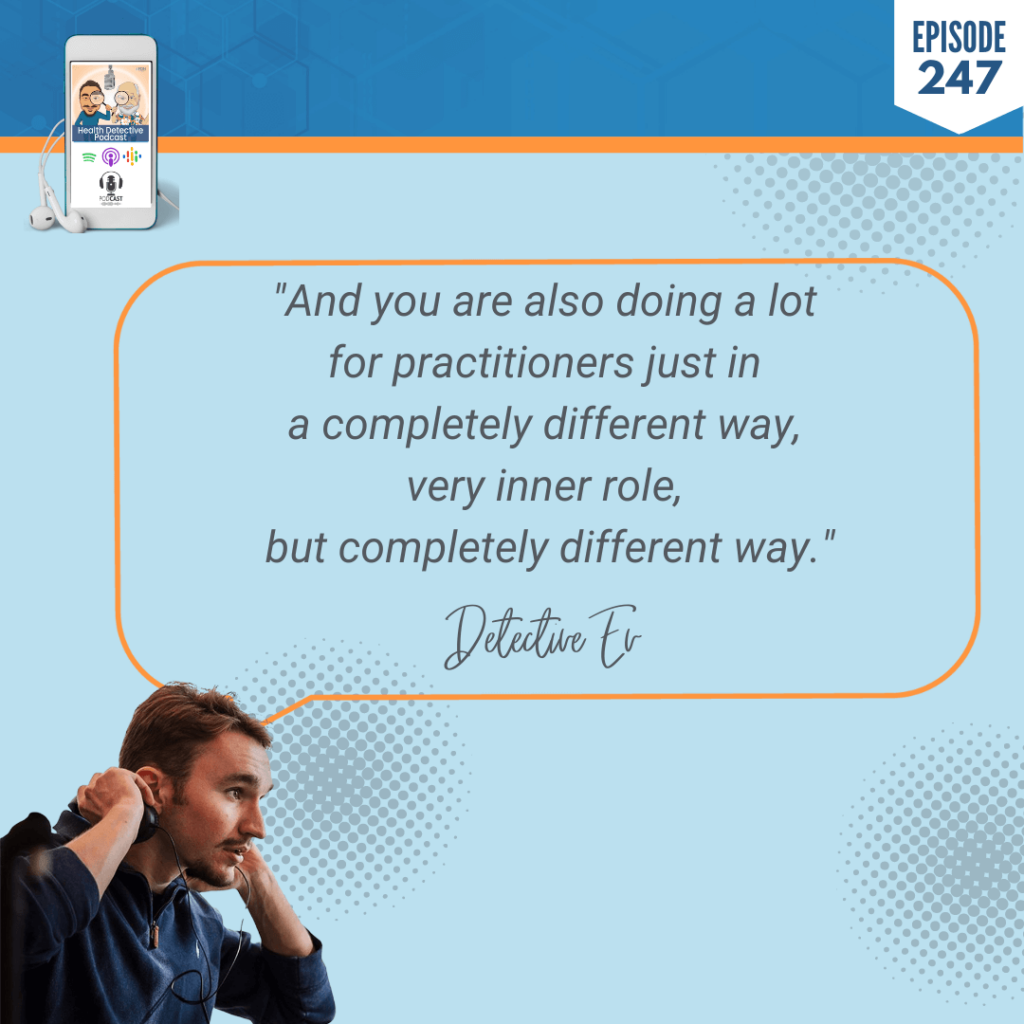
If it wasn’t for her giving a talk that day, I honestly don’t know if I’ve ever heard of FDN organically. I would’ve always heard it from someone in the community. So, I don’t think I would’ve known about this had it not been for Jenn, which is kind of crazy looking at all the stuff I’m doing with them now and just how much it’s helped my life and my family’s life. And you are also doing a lot for practitioners just in a completely different way, very inner role, but completely different way.
Then I found out all of 30 seconds before recording that you actually have a health story, which I did not realize. Guys, what we’re about to do is totally authentic, totally organic. I did not know Jeremy actually dealt with health stuff. So, before we talk about Biocanic and the thing that you created, let’s just start there. What did the health symptoms look like and what were you going through?
Biocanic: Lots of Testing, Lots of Data
[00:06:42] Jeremy Malecha: Yeah, I mean, look, I was Jenn’s first client, right? So, any typical FDN graduate does start on themselves in the course and then they start with their friends and family.
Detective Ev: Yes.
Jeremy Malecha: So, I was obviously the first guinea pig. But background, biomedical engineering, have been in traditional healthcare my whole career. I wanted to be MD, PhD, got into medical school, decided I couldn’t get into the research program, so I ended up in the industry.
I’ve worked for acute care EMRs, GE Medical Systems, done cardiovascular AI, machine learning, practice management, telemonitoring, really technology based in the healthcare industry. As Jenn was graduating from FDN and starting into her practice, I was a late thirties male going through everything that they go through.
Oh, I’m dealing with weight gain, brain fog, afternoon headaches. Everybody who’s listening to this knows that that’s not normal. But what else is going on? And I was trying to do all the right things, gluten-free, organic, sober months, working out all the time, taking all these random supplements. But all of my objective markers were going in the wrong direction.
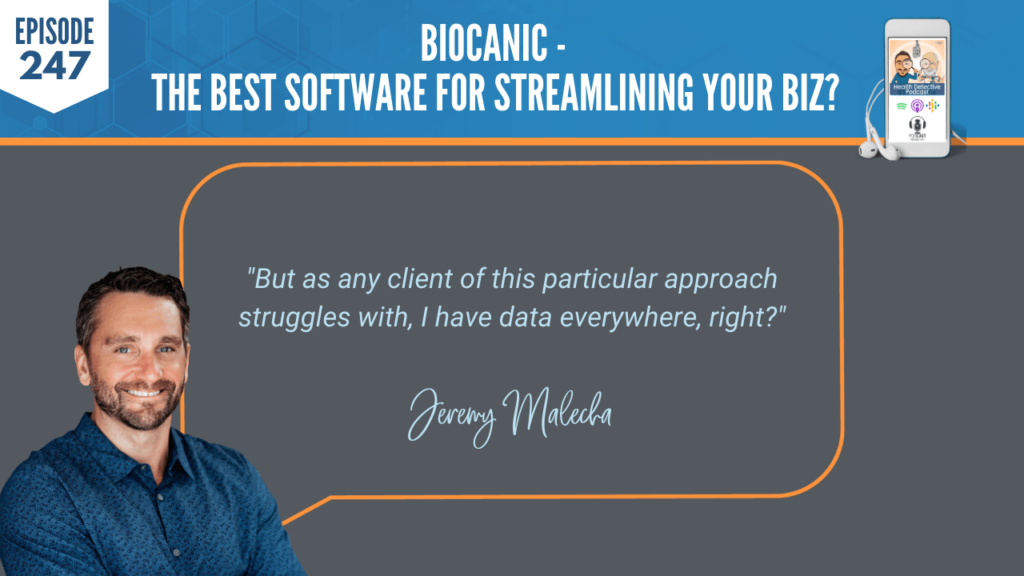
I always say, I got to the worst day of my life when the scale hit 240. And that was November of 2016, I think. That really was kind of like the turnover point for me, cause I felt like I was doing the right things. But as Reed says, I was stuck in a cycle of trial and error. And so, with Jenn, we went through a lot of the different testings, a lot of different approaches. But as any client of this particular approach struggles with, I have data everywhere, right?
Biocanic: Resolving from Force Fitting
I had multiple PDF documents in my lab results. I’m doing intake forms in Excel. I jokingly say for those that are still using the Excel spreadsheets, that Excel spreadsheet for the adrenal stress causes, adrenal stress indicators, almost caused a divorce from the pain it was doing to fill it out. Right?
And I’m getting my supplement recommendations. The Word document looks great, but I have a Word document and an intake form, and I’m tracking my health, I had a spreadsheet of all of my different markers that I was entering; and that’s really why we created Biocanic.
It was my experience in the traditional healthcare world is in practice management or EHR EMR systems, they’re built for the care delivery model. And if you think about it, if you have a chiropractor, they’re probably using ChiroTouch. That software system is built for chiropractors. You can’t take a chiropractic system and go drop it into a podiatry clinic or a pulmonology clinic, or skilled nursing.
What we saw was that people were taking what is the traditional practice management model and trying to apply it for what is a longer-term care program. Right? And when you think about a typical practice management, that is a primary care physician who’s charting and documenting for the purposes of billing, referring, or writing a prescription.
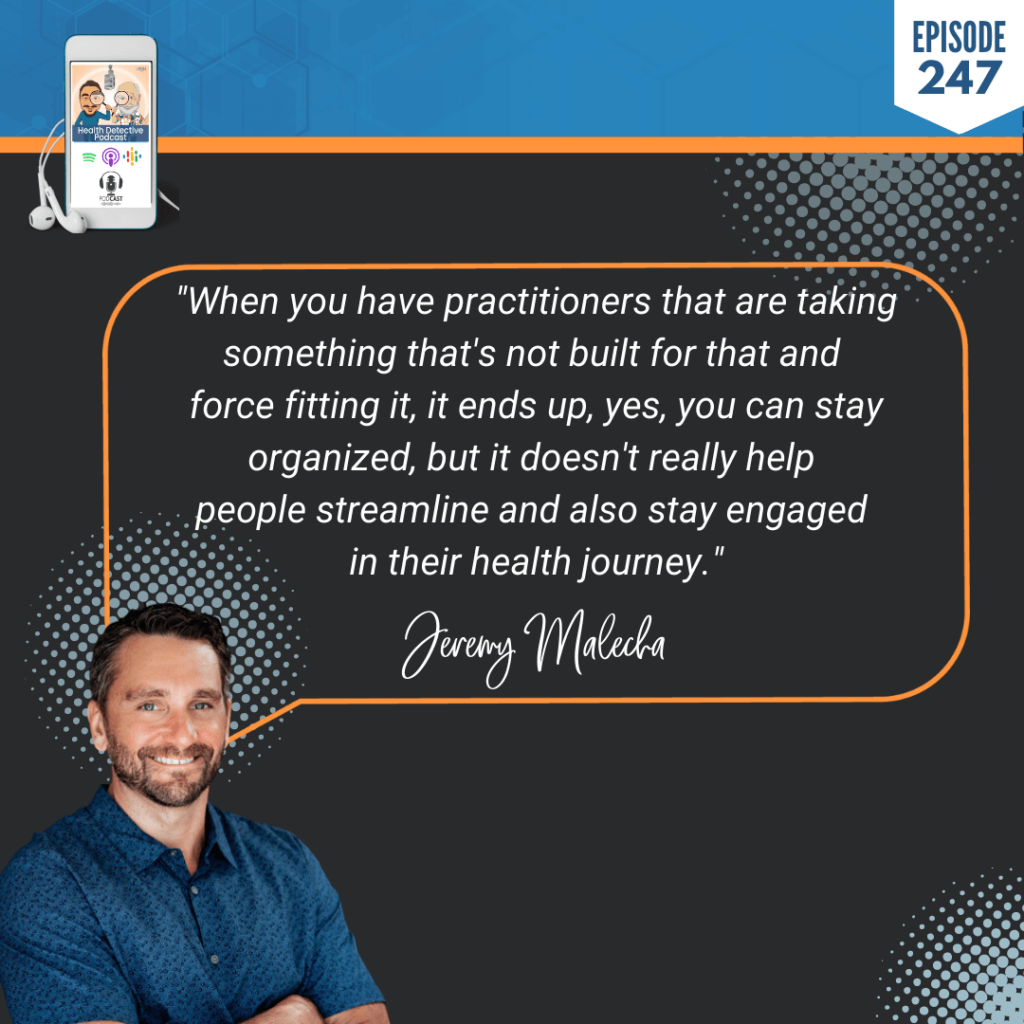
So, when you have practitioners that are taking something that’s not built for that and force fitting it, it ends up, yes, you can stay organized, but it doesn’t really help people streamline and also stay engaged in their health journey. And so, as somebody who’s going through an FDN program, you know, they’re making changes along the way.
Biocanic: A Beautiful Merging
It’s not D.R.E.S.S. all the time, right? It’s diet one week and then it’s stress, and it’s management. So, what we wanted to solve for is how do we create a streamlined system that helps practitioners understand the data faster and more efficiently. But also, really focus on my experience as a client, which is help me see where I’m at in my journey, where I’m going, and the value that I’ve been given as a part of my investment in my health.
[00:10:21] Detective Ev: Right.
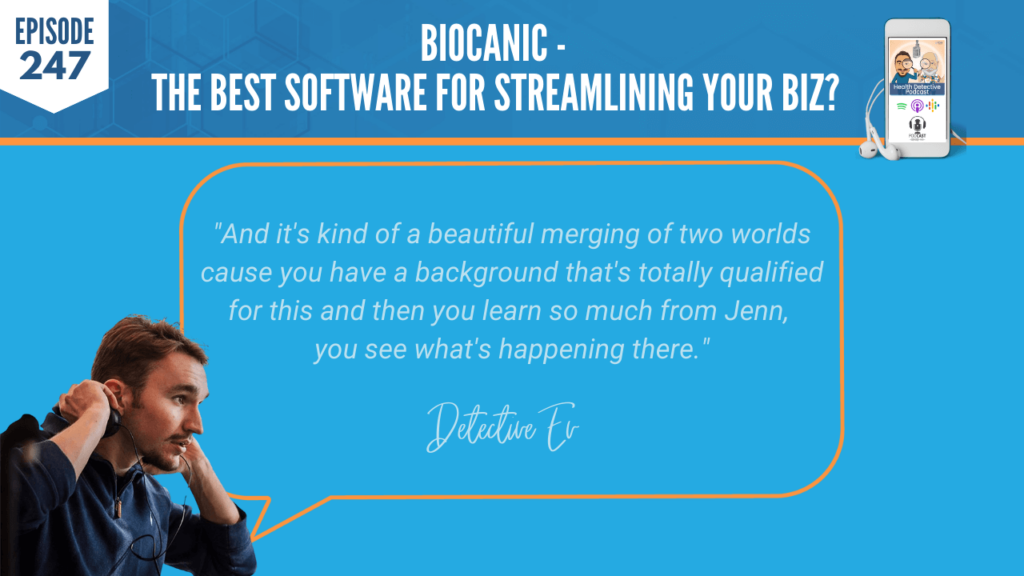
Well, I’m sorry that you dealt with this stuff, but at the same time, that is kind of cool. It gives you such a real-life experience as to what was happening. And it’s kind of a beautiful merging of two worlds cause you have a background that’s totally qualified for this and then you learn so much from Jenn, you see what’s happening there.
But then you also have the client experience to a degree where you get what it’s like to just be in that cycle of trial and error, thinking that things are normal. Even once you realize that they’re not, it doesn’t mean that it gets fixed overnight. There’s still a lot of work that needs to be done and it’s almost kind of better when you’re ignorant with it.
You’re just like, oh, okay, this is fine. This is because I’m getting old or something. But then you realize, late thirties, especially for a guy is not old at all. I mean, there are some studies now saying that the thirties to forties should be primetime for males in terms of physical fitness. Now that’s not what we always see, but that’s what it’s supposed to be if we take care of ourselves and choose to do so.
Biocanic: Opportunity to Scale Practitioner Practices
I think one thing that we can just get started with right away, because Jeremy, we have plenty of people that are listening to this show that are considering FDN. So, the business side to them is like the next step. They kind of know that it’s going to be something, but they might not fully understand what that’s going to entail. They know it’s overwhelming, it’s not something that they’ve done before. So, we have that part of our audience.
Then we have FDNs that are in AFDNP, they’re in the professionals’ group that we offer to people post-graduation, and they’re very experienced in business. So, to the degree that we’re able to break it down for both of these people, what is Biocanic and when did you decide, like, you kind of already have alluded to it, but when did you decide, all right, I’m going to go create this specific thing for the practitioners and the clients, really?
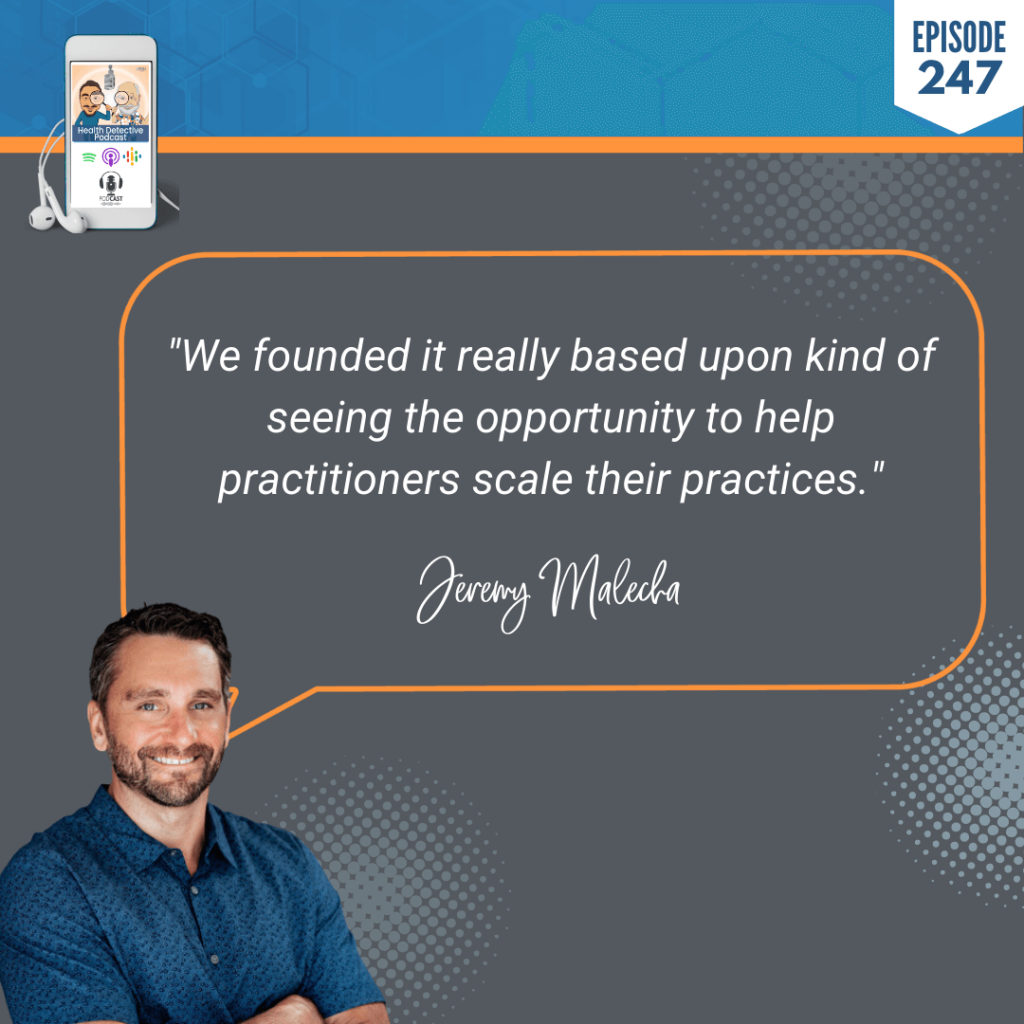
[00:11:53] Jeremy Malecha: I mean, so we founded it really based upon kind of seeing the opportunity to help practitioners scale their practices. And that really became apparent as my wife was starting to scale her business. When I talk about the features, and I even did this on sales calls today, I call it dog-walk complaints that turned into product features in our system, right?
We would be walking the dog after dinner, as we do pretty much every single night, and she’d be complaining about a client for X, Y, or Z reason. Right?
Biocanic: Connecting the Dots
Hey, I asked them two weeks ago as a part of the sleep program, did you get to bed before 10:00 pm? And of course, they would show up two weeks later and they’d be like, yeah, I think so. Right? But you know, 80%, okay, probably did. But they don’t remember back last Wednesday when they stayed up till midnight, had too much alcohol, had a fight at work or anything, and they didn’t connect the dots between that particular day and the impact it had on their health. They lost the insight.
And everything about FDN is so critical because it is so data driven that when you start to connect the dots, that becomes the teaching moment. So, when we think about not only the metabolic side, but also the emotional and the connection and the behavioral side. That’s what’s so critical, right?
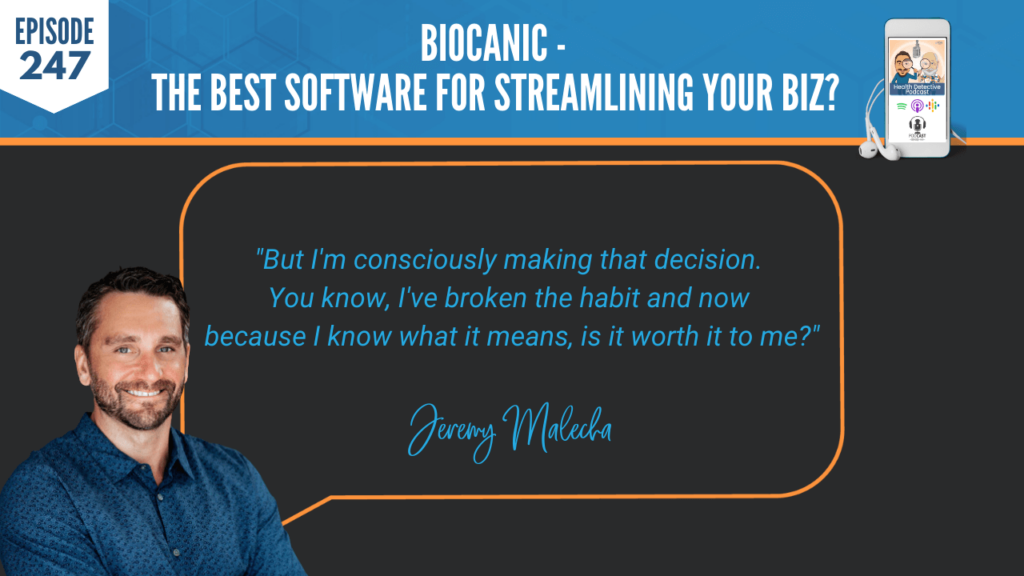
Because now I can say, okay, look, I’m going to stay up till midnight. I’m going to have too much to drink and I’m going to feel like heck in the morning. But I’m consciously making that decision. You know, I’ve broken the habit and now because I know what it means, is it worth it to me?
We always joke, you know, Jenn and I were talking about like, is the bread worth it? I know how bad I feel when I eat really bad, US-based, gluten enriched bread. I get zits, feel horrible, bloated, brain foggy; it’s not worth it. But then there are times where you’re at the artisanal bakery or in France, and you’re like, yes, it’s absolutely worth it.
Biocanic: Systematic Approach
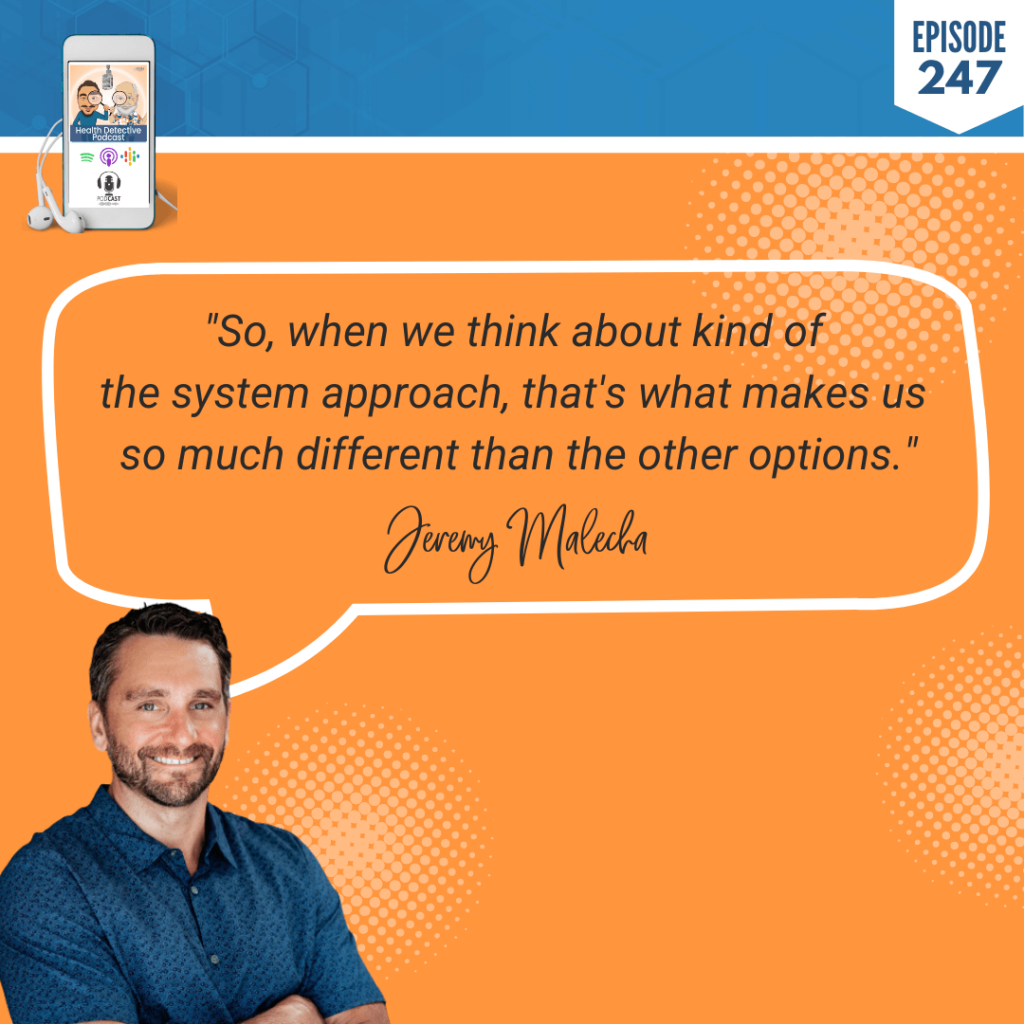
But the ability to have the accountability and the understanding to connect the dots, to really become that health detective and help your client become their own detective and understand it, is what’s so critical. So, when we think about kind of the system approach, that’s what makes us so much different than the other options.
[00:14:10] Detective Ev: This is why I wanted to do this, right? I keep learning more as I talk to you. Just to give a background, Jeremy and I, I guess we had met briefly in person at a conference a couple of years ago, but it was very fast. There’s a lot of people there. Then we were both at CellCore, their conference in Boise, Idaho basically last week.
We both had a lot of downtime cause people would actually go listen to the speakers. What a concept. And I got to really explore Biocanic. It went from something that I’ve just heard about. I’ve heard about all these softwares. I wasn’t using any, cause I’m not someone that takes on 10, 20 clients at a time. It’s just family, friends here and there. Even as my own business is developing, I’m more the sales and marketing person and then I give it to the other practitioners. But I was excited for this stuff for them.
Then what you just said, I didn’t realize it was so client focused in this sense. Because you’re right, like as an FDN, you almost take this for granted. I am so aware and so are all of the graduates, I would imagine. I’m so aware that if I do X, Y, Z things on this day, it’s going to have a consequence the next day. Sometimes we know this by the hour.
Biocanic: Enlightening Clients
I know if I stay up till 11:00 pm versus 10:00 pm, even if I got the eight hours, seriously, still to this day, my neck gets kind of tight, I get kind of stuffy. It’s not the end of the world, goes away in like an hour. But it’s an hour of sleep. I didn’t even lose sleep overall, I just shifted the hours around and I noticed, wow, that does affect me. Like, that doesn’t feel good.
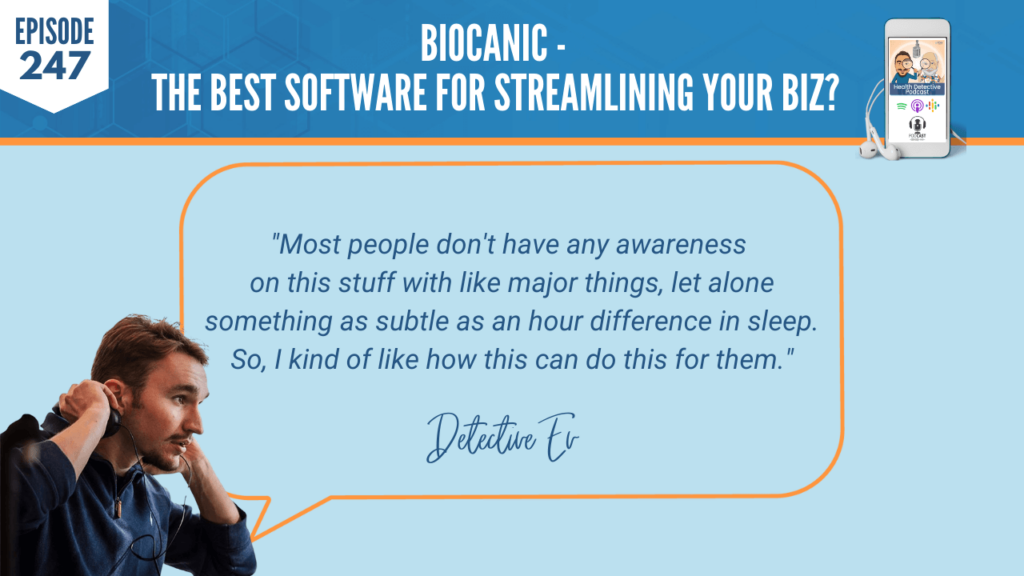
I also beat the heck out of my body when I was younger with the health issues and staying up till four in the morning every single day, like even on school days. So, maybe I’ve tapped out my returns a little bit in that sense. But it’s crazy how I can feel like Superman one day. And now I feel like I have the kryptonite on the next day just by doing something for an hour. I mean, most people don’t have any awareness on this stuff with like major things, let alone something as subtle as an hour difference in sleep. So, I kind of like how this can do this for them.
Now, I think it might be a good way just to even describe Biocanic in full. I think what people compare this to, if I’m missing anything, let me know. The two software seem like Practice Better and GetHealthy. Is there any other quote/unquote “competitors” or similar services on the market?
[00:16:08] Jeremy Malecha: Yeah. I mean, there’s quite a few of them that are all similar. So, when we kind of differentiate on what we do, we always like to talk about what we do better, not to talk about the other models.
Detective Ev: Fair enough. I appreciate that.
Biocanic: A Simpler Way to Correlate
Jeremy Malecha: The other models, again, are really built around the traditional healthcare system approach. It’s a great way to stay organized. They have a pretty interface, but it doesn’t connect the dots for the individual client. And one of the other examples, again, from my particular health experience is this was actually back before GI MAP when FDN was teaching on BioHealth, which doesn’t exist anymore, right?
So, I had the BioHealth Microbiome test, and was buying Thorne, Dipan-9. I remember the conversation going, why am I buying this $80 bottle of supplements? Jenn would say, don’t you remember on page three of the BioHealth 401H report, you have, I don’t know, C-diff or something, right? And this is to help support your digestive process. I was like, I don’t even know what report that is cause I have five, and I don’t know what that means.
So, when we kind of talk about the other options, that’s still the experience, right? Yes, it’s organized. I can have a PDF and a lab result. But I, as an individual, don’t connect the dots. Because when we process all of the lab data, we’re going to say, we’re going to look at an MRT next to a GI MAP, next to a DUTCH test, next to a stress hormone panel or whatever you’re running, or the blood chemistry as well, and we surface the out-of-range markers.
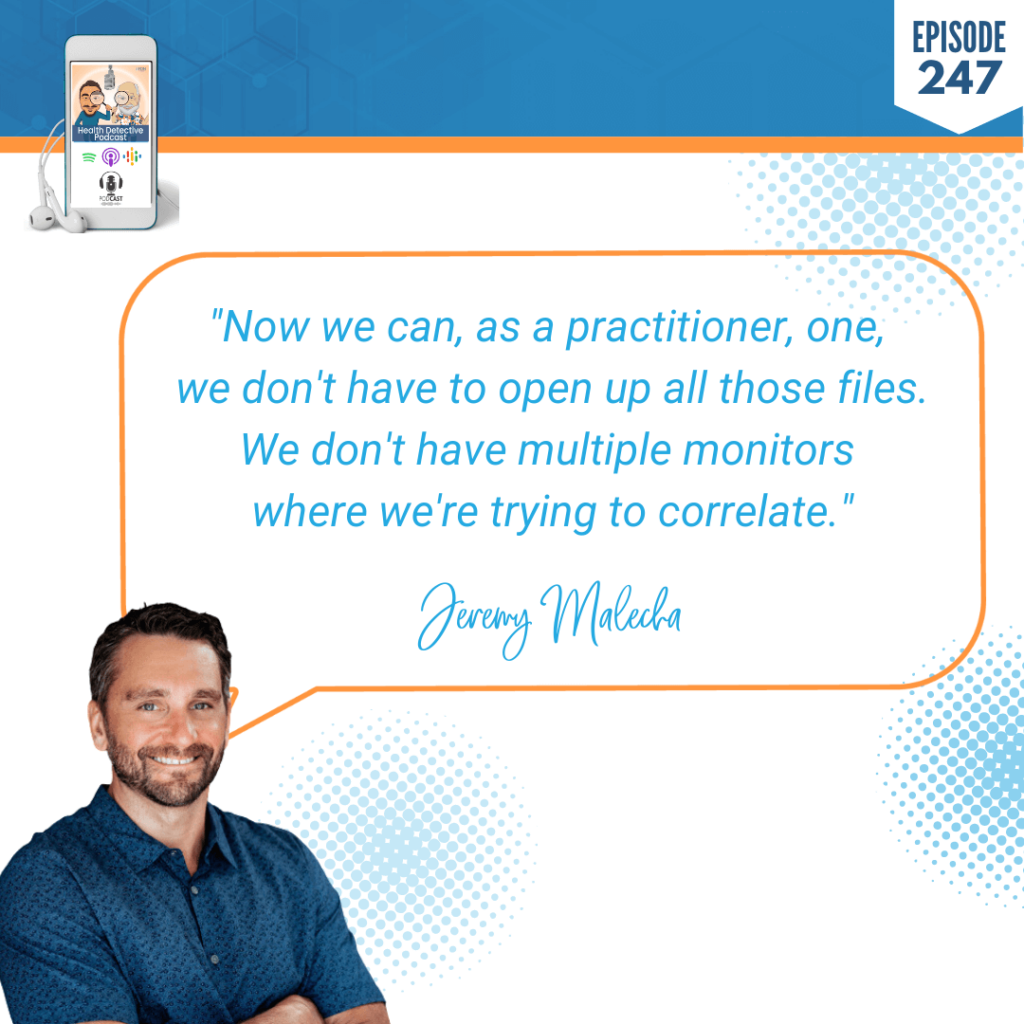
Now we can, as a practitioner, one, we don’t have to open up all those files. We don’t have multiple monitors where we’re trying to correlate.
Biocanic: Coming Together in One Single View
I think it’s module eight, where Reed has all the different lab tests on the PowerPoint slide and stuff. It’s all right in front of you so you can see it right away. But for a client, now, I can actually see, look, I have gut dysbiosis, I have a litany of food sensitivities, and my hormones are out of whack.
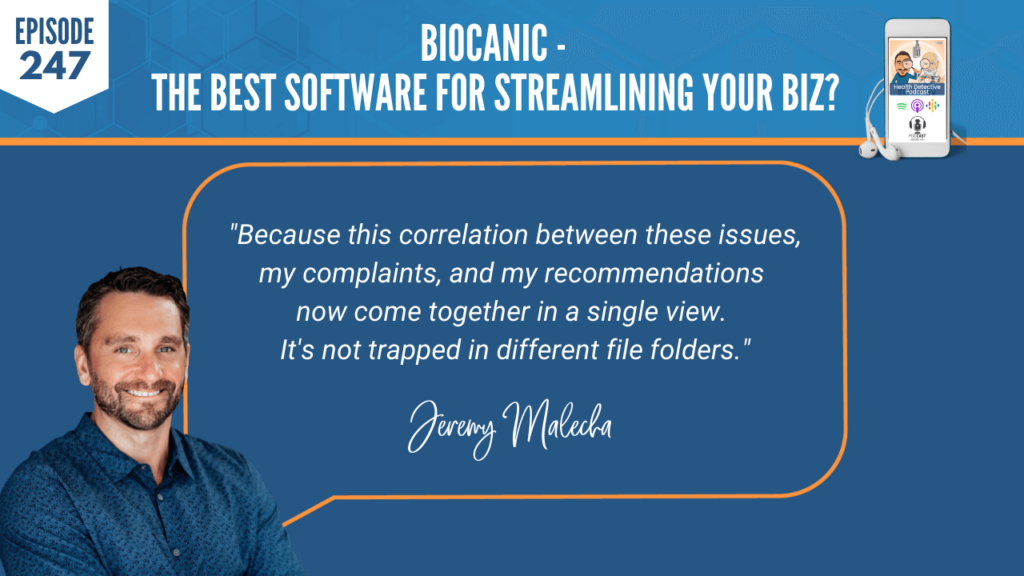
Therefore, I have my adrenal protocol. I have my gut support protocol, and this is why. Because this correlation between these issues, my complaints, and my recommendations now come together in a single view. It’s not trapped in different file folders. And that’s where we try to create a different experiential approach for practitioners and their clients.
[00:18:30] Detective Ev: Well, I think at this point, the best thing to do, and I’m sorry, because I know our audience is mostly audio based. But you guys know I refer you to our YouTube every now and then. So, I will have the link in the show notes for you where you can check this out.
But I’m going to have Jeremy pull up a screen so that we can actually see this. Because I feel like there’s just so much to look at and it will make a lot more sense for people if they can see it in the same way I got to when I was at the conference. So, we’ll do our best to talk about it in such a way that you could still enjoy this if you’re in the kitchen or you’re driving in the car.
But I think it’d be best for you guys to head over to our YouTube, cause Jeremy’s about to share his screen. We’ll see the interface here and how it’s a little different from other things.
Biocanic: The Client’s View
[00:19:05] Jeremy Malecha: Yeah. This is my particular dashboard. Most dashboards aren’t as busy as mine, so I do have all the connected wearables and everything.
But one of the big differences, especially around the FDN approach, is when we look at what we call the functional summary. This is where we combine all of the different information. I have a ton of lab testing, including stuff that most FDNs wouldn’t run. But we do it cause we support a lot of different practitioners.
But what we see here, think about the correlation. So, we have our client reported, you know, what are our goals? What are our complaints? Our Metabolic Chaos Scorecard, so obviously, this is the older version. But we can see the scores side by side, how that self-reported data is improving.
And then I’m just going to zip over here. Here I have my Oxford MRT. I’ve actually done a genetic test, a GI MAP, and a DUTCH test. What that means is instead of having to go to a file folder, lab results, and open this PDF that I think is 20 pages long with the actual recommendations on one page without the MRT report. Great report, comes in a binder. But the data that you really need is what am I really reactive to?
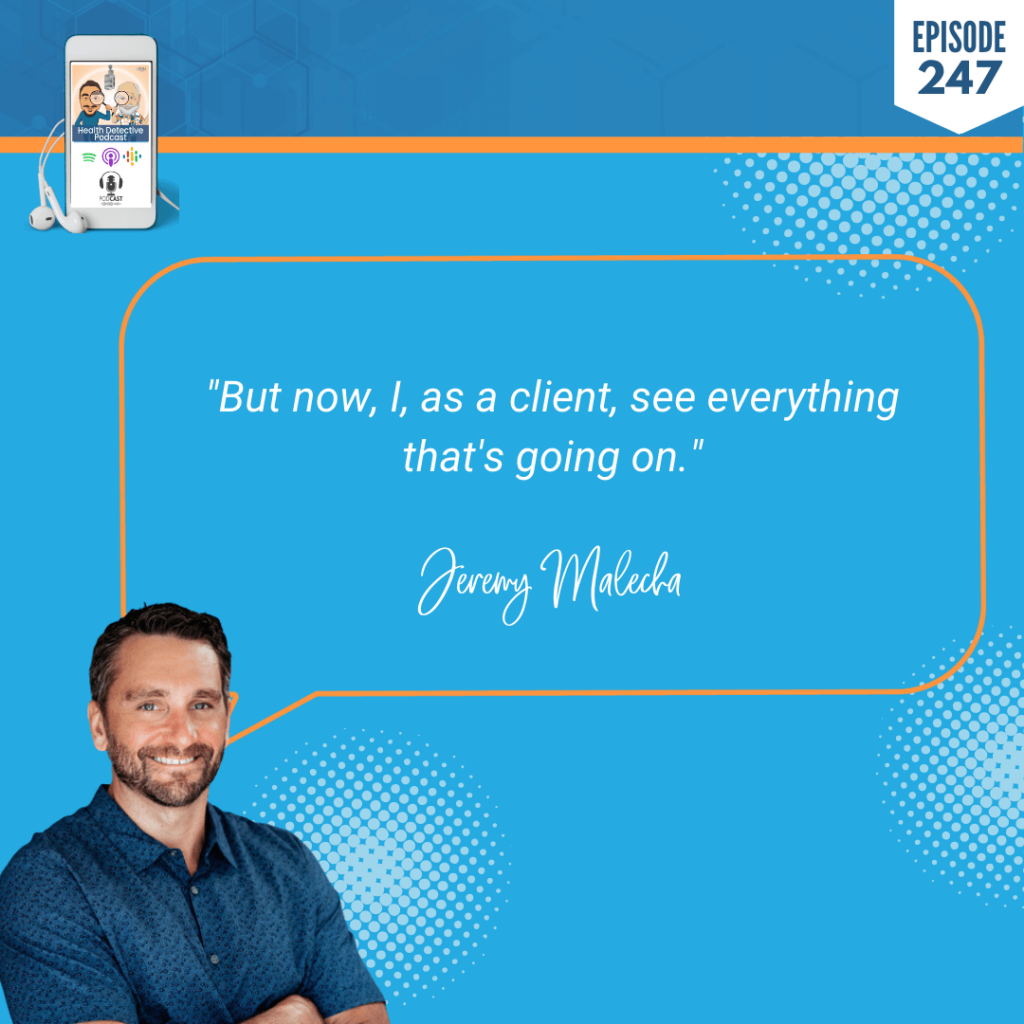
My GI MAP five-page report, my DUTCH test, which is a 15-page report, I can see, as a practitioner; I can see everything that’s going on with this individual. I don’t have to go back and reopen it; I can see as it’s going. But now, I, as a client, see everything that’s going on.
And then when you’re retesting, this is where the value comes in. You’re going to do a pre and posttest.
Biocanic: Tracking Multiple Test Results
So, part of my health journey was estrogen dominance, and so here we have eight DUTCH tests. I know that sounds gross, I think I’m in the top 10 at Precision Analytical for running the test. But why it’s so critical and why I run it so regularly is if you’re familiar with the DUTCH test and the estrogen pathways, if we go back to 2017, and I’m not trying to train everybody on a DUTCH test, I would present as if I was low T, weight gain, andro weight gain, afternoon headaches, low libido. My issue, if you look at kind of the testosterone metabolite, was relatively normal; my issue was estrogen dominance.
Had I walked into an MD and gotten on testosterone therapy, it would’ve been an absolute disaster for me because my estrogen pathways were so clogged up. So, I’m generating a ton of estrogen. You see, everything’s out of range. My 4-OH is almost off the chart. Family history of estrogen dominance. I’m a poor methylator and you can actually see that over here as well.
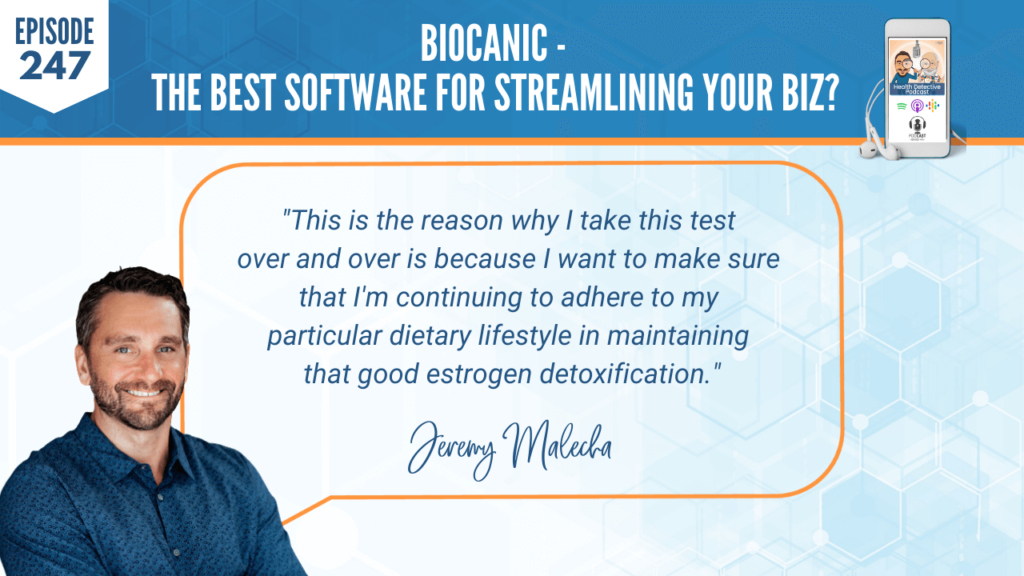
This is why I’m kind of going to this, is when we actually look at my individual health journeys from the last six years and we go look at those estrogen markers over time, we can actually see that this is where I started. Again, this is that cancer-causing pathway and this is where I’ve been. This is the reason why I take this test over and over is because I want to make sure that I’m continuing to adhere to my particular dietary lifestyle in maintaining that good estrogen detoxification. This wasn’t like one time; this was having to follow along.
Biocanic: Motivating Clients
And you can see I had some aberrations along the way. So, for me it was about how do I stop filling the tank? How do I empty the tank faster and get back to estrogen balance? This process court was absolutely parallel to me losing 40 pounds. And so, this is where it all comes together for individual practitioners.
[00:22:25] Detective Ev: This is so cool cause I feel like, especially for the client, one of the problems always is retesting, like, encouraging them to do so. But I feel like this is just so rewarding. If I was working with a client, I would show them someone else or myself, just like you have, and show them, hey, look at this graph over time.
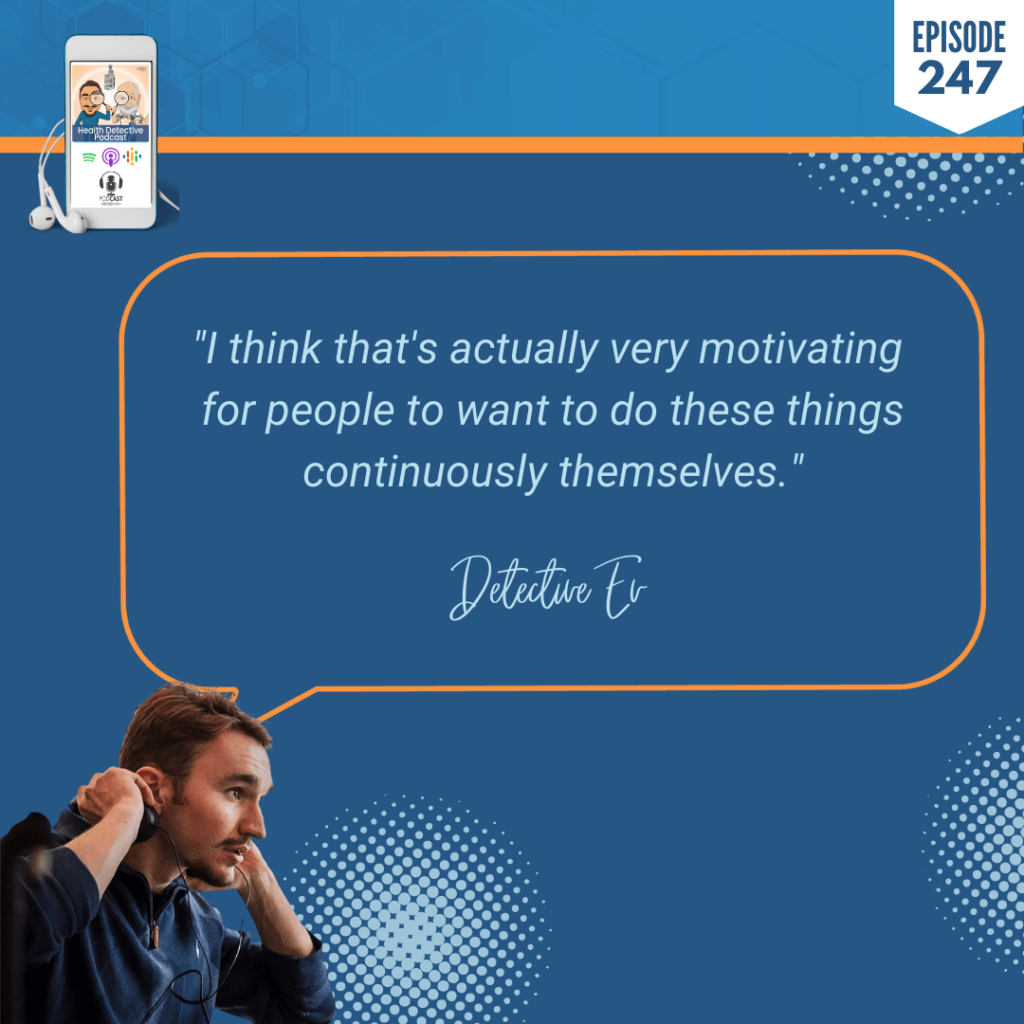
And I don’t know, I think that’s actually very motivating for people to want to do these things continuously themselves. It’s so odd what motivates us as human beings. I haven’t figured that out perfectly yet myself. But I know it’s amazing when I just post labs online, that gets so many people asking questions. We’re very driven by the data, even if we wouldn’t consider ourselves like a normal data-driven person.
So, what I want to know then for my client, if they are looking at their dashboard and I gave like a bunch of recommendations this past week, is there an easy way to pull up what that might look like if you’re the client or I’m the client, like what did they get last week?
Biocanic: Efficient and Streamlined
[00:23:14] Jeremy Malecha: Yeah. One of the things that we do that’s, again, different, is when you think about kind of the report of findings, or this follow up report. You want to create that report and recommendation. Because we have all the data, we have what’s called the summary report generator.
So, if you think about taking your practicals and you’re having to summarize everything, we can actually pull in all of that information. We have our supplements, our scored self-assessment. Let’s say we’ve run that metabolic scorecard. I’m just going to include, let’s say, the GI MAP just for simplicity. Then this is kind of our typical interpretations.
So, let’s say we have our estrogen dominance kind of lab results assessment, and then we’re going to set up our D.R.E.S.S. plan, whatever step that they’re in. In that five-step process, you’ve basically created a follow up professional report, once it loads, in a second.
We can see that we’ve pulled everything together. Sorry, I’ve taken the GI MAP about as much as I’ve taken the DUTCH test. You can see here’s the metabolic scorecard scores, the out-of-range markers. You don’t have to copy and paste from the PDF documents.
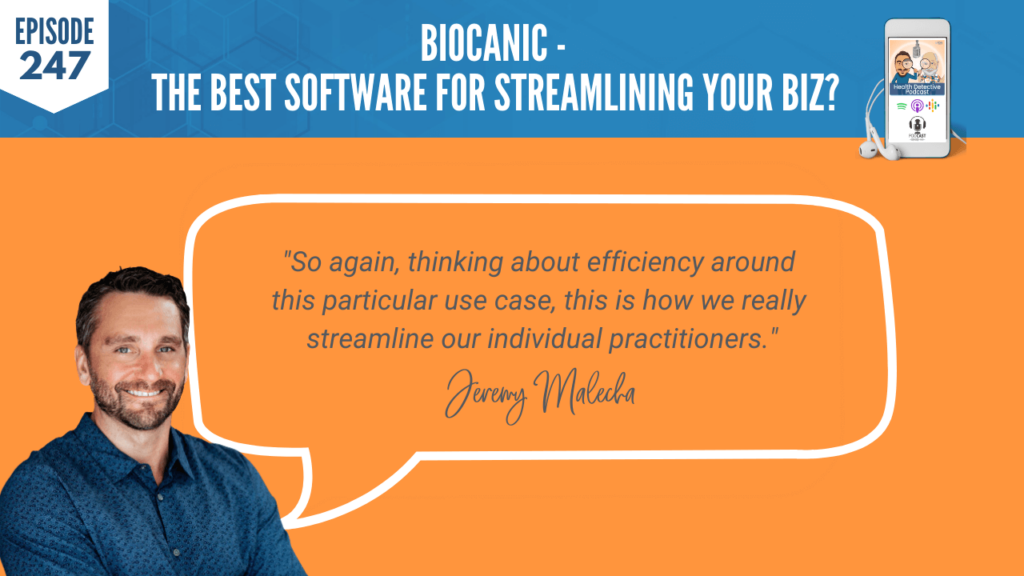
Then we auto fill in whatever that interpretation assessment is, then our plan, and our supplement recommendations here at the bottom. And we’ve completed that follow-up report in 30 seconds. So again, thinking about efficiency around this particular use case, this is how we really streamline our individual practitioners. Yes, you can do this without our system, but it takes a lot more work.
Biocanic: It’s About Optimization
And so, when you think about the goal and aspiration of a new graduate who wants to be serving 10 or 20 or 50 active patients or clients, those kind of 15, 30, 45 minutes start to multiply up. And without the right system in place, you get stuck.
That’s really where we found so much success in the industry is busy practitioners are buried in, yes, the files are really organized, but they can’t get to the data. Then it’s five minutes here, 10 minutes there, 15 minutes here, and they can’t take on any more patients. Then they can’t really achieve kind of the business model that they’re looking for.
[00:25:25] Detective Ev: Right.
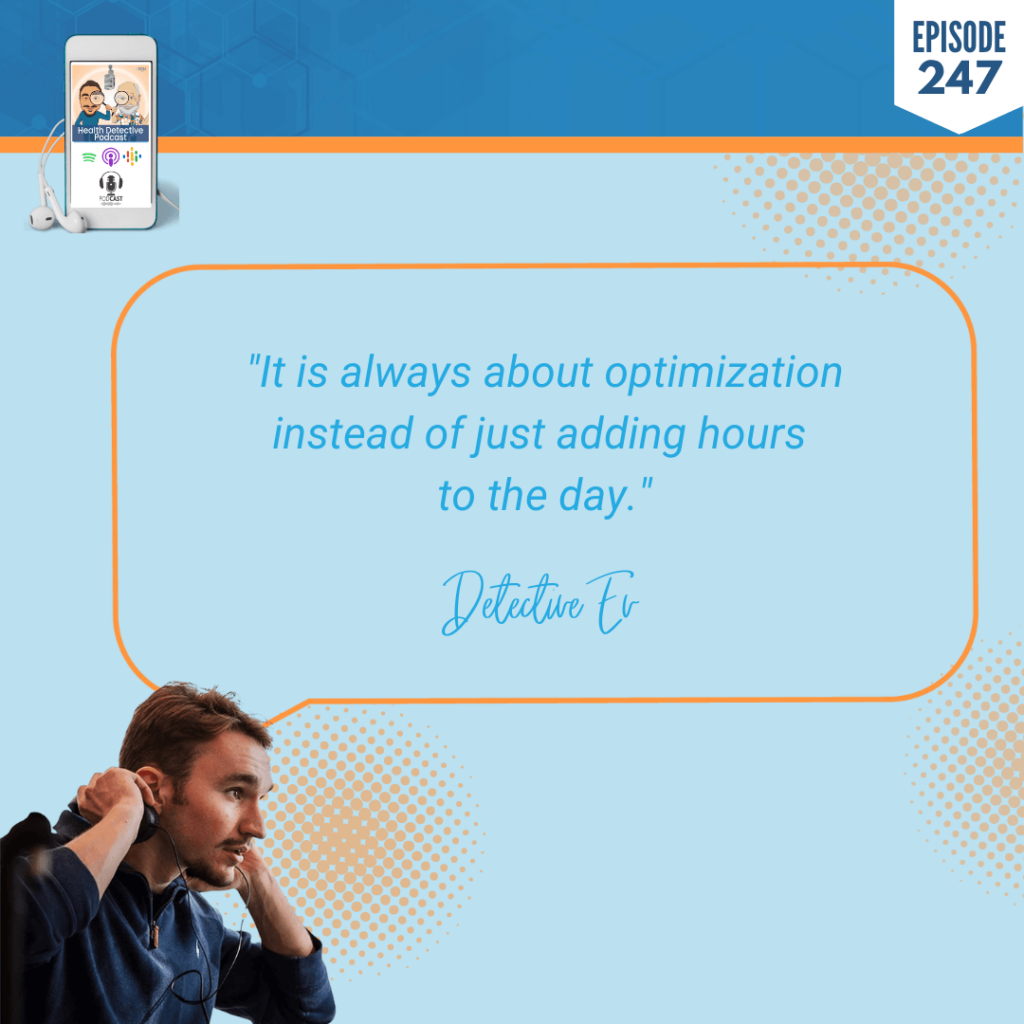
This is hilarious to me knowing Jenn, because I’ve always admired her. I look at her as like the queen of optimization. I’m like, oh, okay. Here’s the king too. Because you guys just get everything that you could possibly get. And it is always about optimization instead of just adding hours to the day.
That’s one thing I think a lot of us, including myself, could learn from someone like Jenn. Her philosophy is her health comes first. Right? She’s never going back to the things that she dealt with. And so, what she’s going to do is say, okay, I’m going to figure out in these, let’s say 40 hours a week that I want to work, how do I get more efficient in the 40 hours? How do I get more useful? Not, how do I just keep adding on hours?
Because the one end is very limited. This other end where you just optimize and get more efficient, that’s pretty much infinite. You can continue to grow as an individual.
Biocanic: Which is Best for FDN Practitioners?
I’m sure there’s a limit on how many clients someone could realistically have. But Jenn has pretty much maxed that out, has gone as high as you can. And she even has programs like PBMS, I went through that briefly, that were all about efficiency and optimization. And this is basically the software for that.
Again, I really appreciated what you said about not ever talking about what another program’s doing badly. I like to do the same thing with FDN, right? People call all the time for the sales calls and ask about this course and that course. I don’t need to be a course basher. And quite frankly, a lot of these places are trying to do the best they can too, and we know that.
The thing is though, I want you to be able to have your minute here and explain to people what the true advantages would be. Because if I don’t know anything else, like if I don’t have anything to compare to cause I’m a trainee right now and I don’t even know about Practice Better or GetHealthy, I mean, you might just trust the podcast and say, okay, I’m going to go do this.
But Practice Better probably has their fancy marketing and they’re going to come in on a Google ad or something. Or I think you said they, ironically, don’t do marketing.
Jeremy Malecha: Yeah.
Detective Ev: Okay. Bad example then. You’re going to hear about these other things.
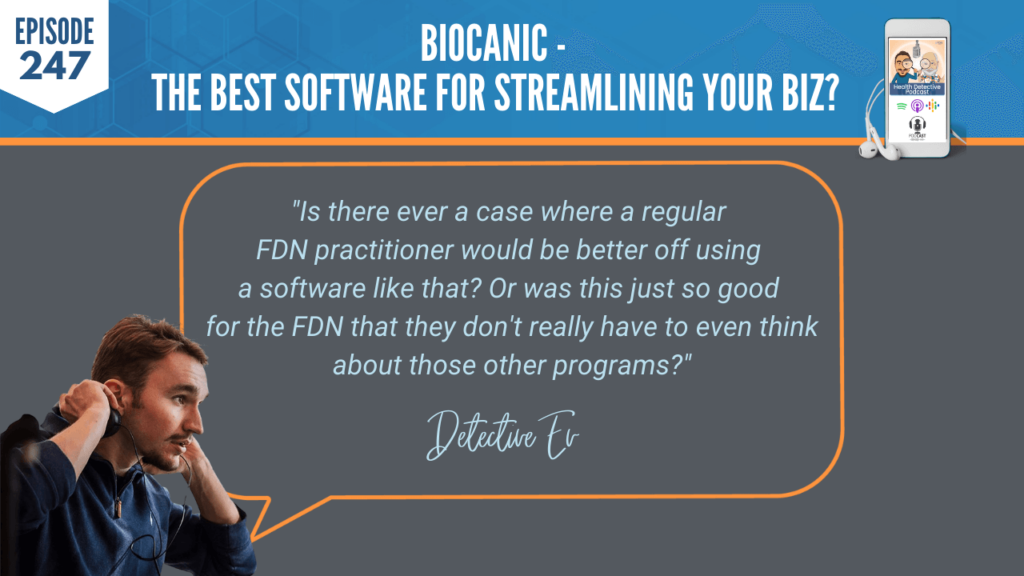
So, is there ever a case where a regular FDN practitioner would be better off using a software like that? Or was this just so good for the FDN that they don’t really have to even think about those other programs?
Biocanic: A Very Different Work Style
[00:27:24] Jeremy Malecha: Look, the other programs are a great way to be organized. So, if you’re becoming an FDN, it’s a part-time thing and you’re going to manage a couple clients here and there, some friends and family, and it’s not really where you want to take your career, it’s just something you like to do, it’s all about the same, right? Because the time efficiency doesn’t really matter.
If your goal as a practitioner is to have a busy practice where you’re seeing lots of people, maybe you’re bringing on other FDNs to help support your business, you have to think about how do I make the investments today to be able to 10x my business tomorrow. To do that, you can’t have this kind of death by five-minute cuts. Right?
The fact of having to go in, open a pdf, open a pdf, shift it, zoom it, move it so you can actually see it and get your focus, if you’re busy, when do you have time to focus? In the evenings or in the morning? And that comes at the expense of your family or your ideal lifestyle. Right?
So, when you think about that, you really need to put the investment upfront. If you want to truly scale your business, scale yourself, scale your approach, you have to have the systems in place to be able to do that. And those systems have to enable your workflow to do it as fast as possible so that it’s not cutting into your personal lifestyle.
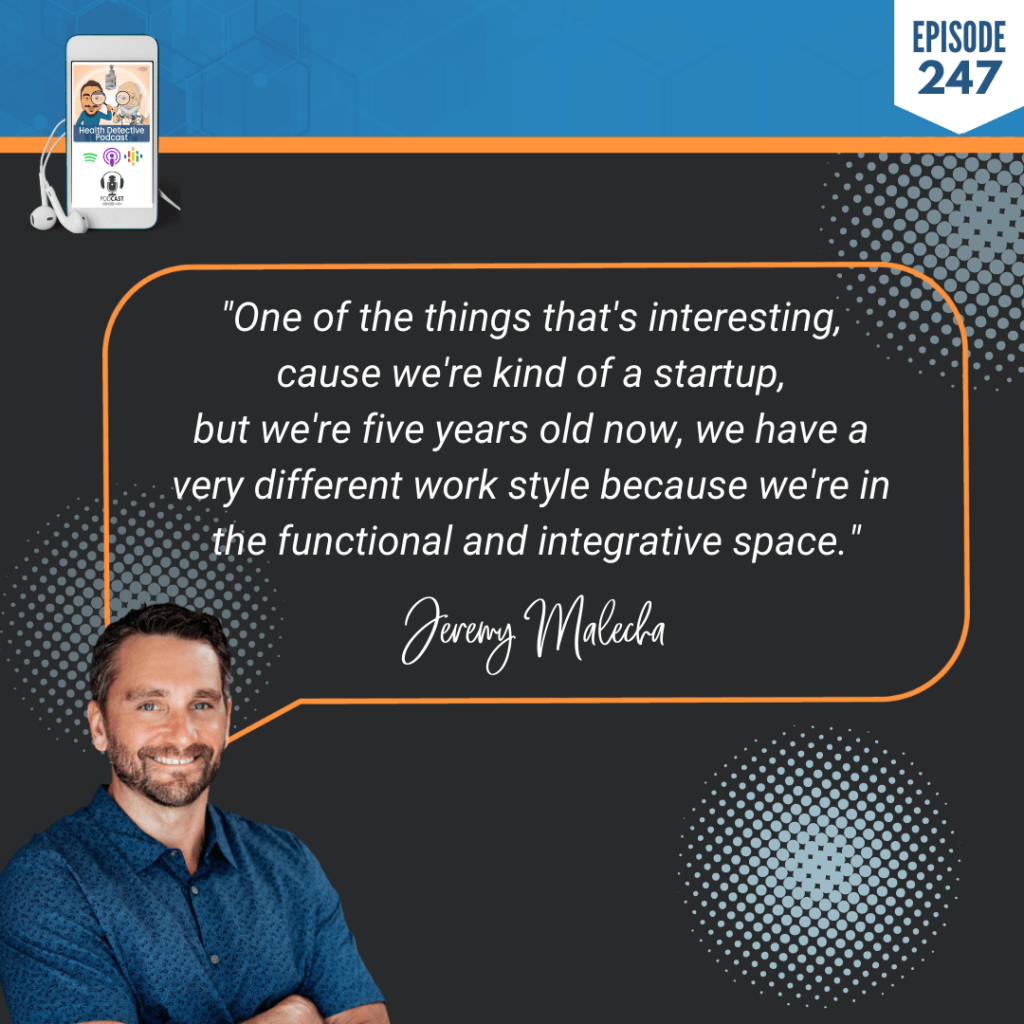
And one of the things that’s interesting, cause we’re kind of a startup, but we’re five years old now, we have a very different work style because we’re in the functional and integrative space.
Biocanic: Plan Ahead, Invest Now
The importance of balance, the importance of getting away from computer, not working 90 hours a week, not grinding it out all day, every day, because you end up getting adrenal stressed, you end up burning out. So, even philosophically as a company, we’re like, turn off your electronics, get off your computer at times, find your work-life balance. Because if you’re out of balance, that’s going to affect your work.
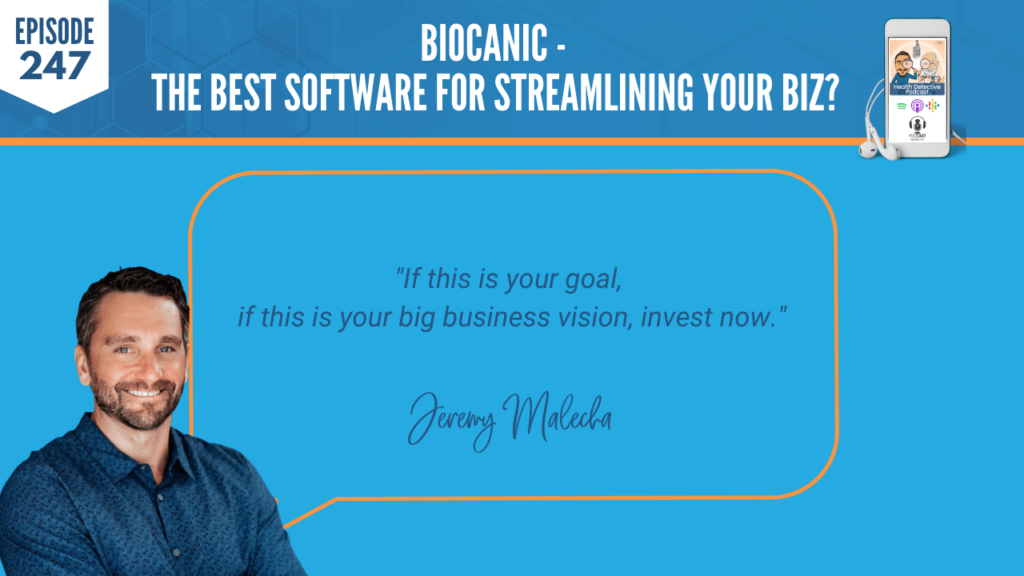
That’s why it’s so critical to have the right systems in place. And we want to plan ahead. If this is your goal, if this is your big business vision, invest now.
Oftentimes we hear a lot of graduates and they’re like, well, I need to get my first client before I start to invest. Think about it the other way. I should invest in my infrastructure before I get my first client. Because when they come through and everything’s streamlined, they have a professional experience, they get everything as they need it, they become your marketing engine, and that’s how you truly scale. If you think about it the other way around, you’re only hurting yourself by not doing it upfront.
[00:29:51] Detective Ev: True. You actually want to deliver as high a level to the first person as the hundredth person. Of course, you’d be improving over time, you’d think, but as high as you’re capable of doing with the first person.
Because at the end of the day, social media is awesome. Giving talks and lectures is great. The best way to do this business and most businesses is word of mouth. People that love you and had a great experience with you saying, you need to go talk to this person. It also makes the conversations around the higher ticket packages a lot easier.
Biocanic: Starting Out Successfully
I can tell you from personal experience that saying, hey, it’s $4,500 on a call, goes much more smoothly when the person, like their wife or husband went through your program and loves you to death, knows you and has had success versus when it was a cold lead from some random Facebook ad or whatever it might be. So, trust me on that one.
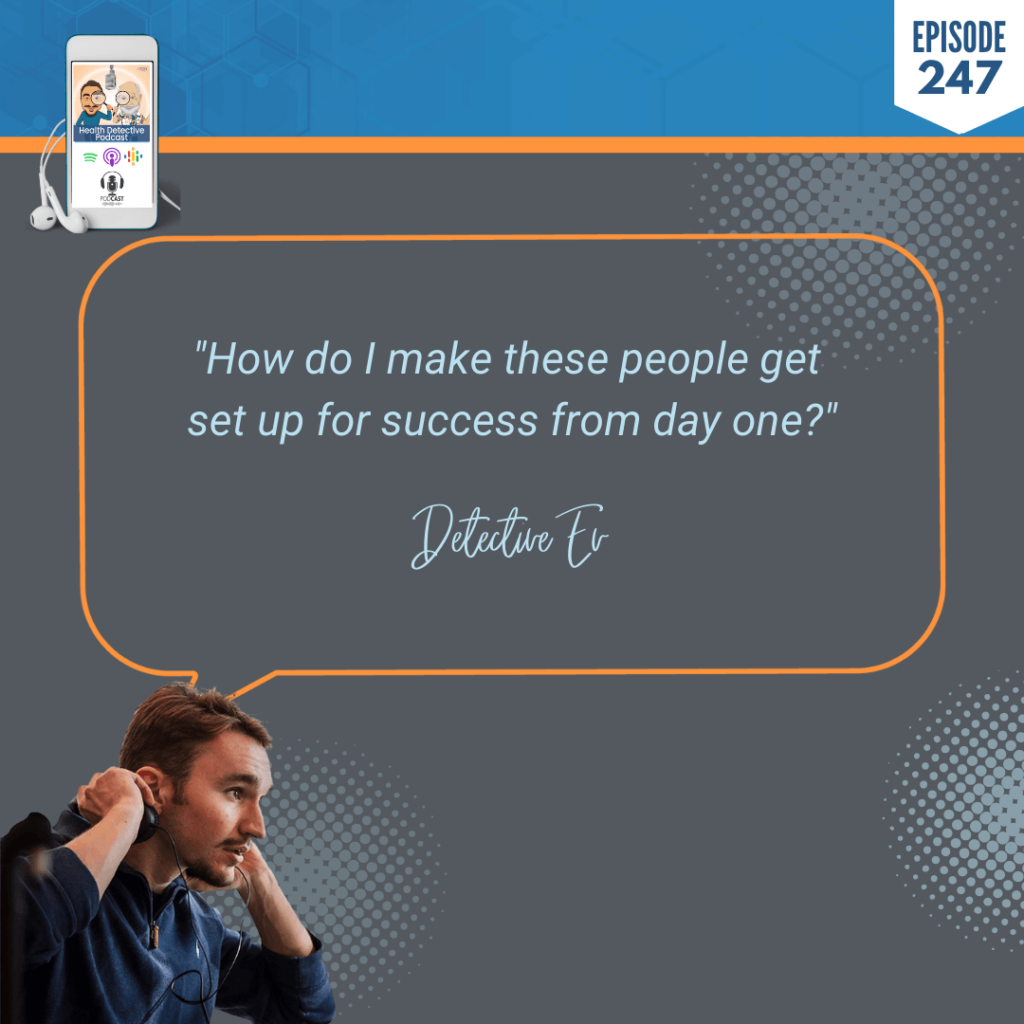
And that’s why I was excited for Maddy, my girlfriend, and Brian, my friend, because I’m like, all right, they’re brand new, literally just onboarding the first clients. And I’m thinking also as like a business owner too, like how do I invest in the employee in a sense, right? They’re more 1099, but how do I invest in the company? How do I make these people get set up for success from day one? That’s why I’m excited to start working with you guys.
We probably won’t get to the full 50 minutes, which is cool. Like I said, it doesn’t necessarily need to be that today. But one thing I think we have to mention towards the end here is the pricing tiers and what they’re going to get. Because I know at the time of recording this, it is currently $35 for FDN practitioners. Is that correct?
Jeremy Malecha: That’s correct.
Detective Ev: Okay. And now I know that you can add things on. Like one thing, I believe, I was talking to Connie about, she was telling me that I can do these pre-recorded things basically, and then include them in my programs. I’m like, dude, duh.
Biocanic: The Core System
I can go with basic D.R.E.S.S. stuff now. I know you wouldn’t know this about me, but I’m huge on circadian biology and light. And I do feel sometimes like it’s not that it’s not worth a client consult, but it’s so routine. There’s no way I’m not going to tell someone this because it really is one of the few things that can be applied to everyone, right? It has to do with sleep and getting morning light.
I’m like, oh, I can just put that into a video format now and include that in everyone’s program and use the sessions for what they actually should be used for, which is maintaining what they need to be doing or going over any current problems they have versus just educating them on something I’m going to teach the other 20 clients anyway.
So alright, the $35 will get me what? What would the next tiers look like and what would they include?
[00:32:07] Jeremy Malecha: I certainly understand pricing can be confusing in our industry cause everybody has their different matrix of stuff.
So, one, the FDN pricing is special cause we were actually built around FDNs, and Reed’s been a very good partner for us as we’ve kind of grown the system. We are a flat monthly fee; we don’t have any like utilization tiers.
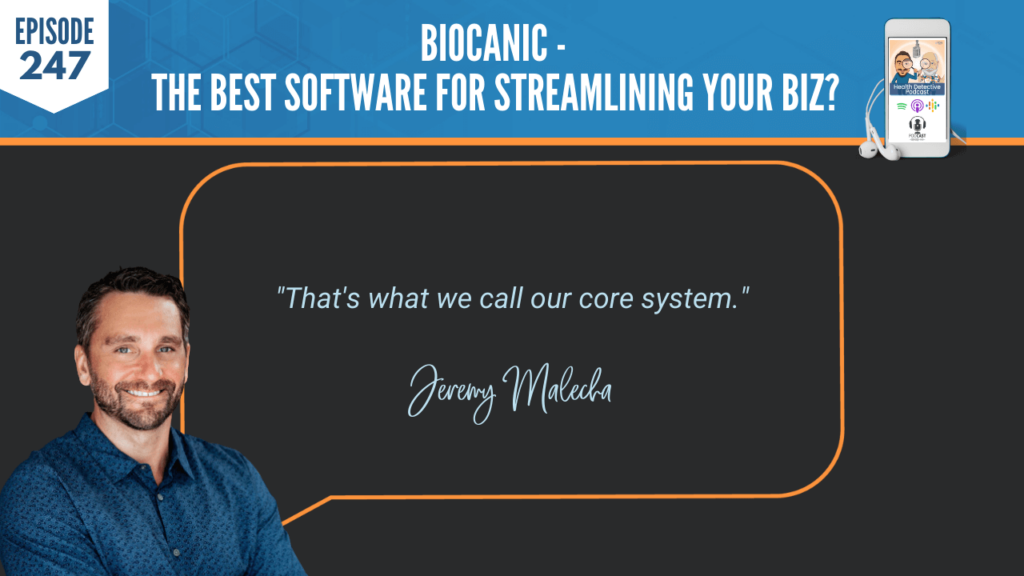
So, sometimes if you are looking at other systems, you’ll see up to a hundred clients or up to X amount of text messages or up to two gigs. We don’t do any of that. It is just the one monthly fee that starts at $35, and that includes intake assessments, the lab processing, supplement recommendations, scheduling. You can do invoicing through your billing account. That’s what we call our core system.
Biocanic: Cheaper Than Any Other Platform
Then we have two additional add-ons. One is the program builder or evergreen content delivery system. So, if you think about a Kajabi or a Thinkific, that’s a $10 add-on. And then we have our precision eating platform, which is, we’ll make recommendations and generate a meal plan for you, for your individual client. That’s a $20 add-on.
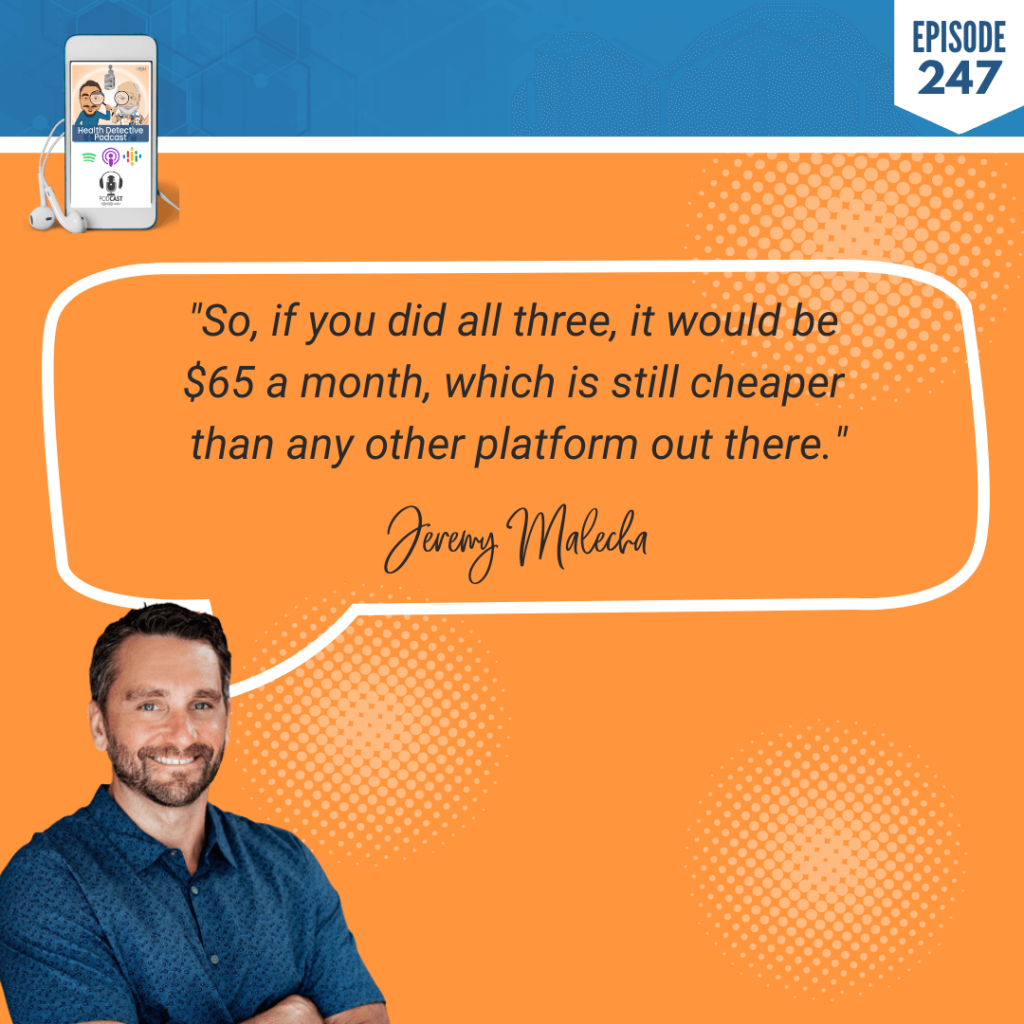
So, if you did all three, it would be $65 a month, which is still cheaper than any other platform out there. And you don’t have the complexity of worrying about your business getting too big and your pricing changing.
[00:33:26] Detective Ev: Well, that’s fantastic. So, you’re saying even just for the $35, if all I ever wanted was the stuff that you mentioned in that tier, I could have a thousand clients and you guys don’t care.
Jeremy Malecha: Correct.
Detective Ev: It’s just, do your thing. That’s amazing.
Then also, just for the video hosting, like evergreen videos and courses and stuff might be a little different, I guess. I guess it’s not, because I think Connie told me you can actually have quizzes in there too, right?
Jeremy Malecha: Yes.
Detective Ev: That’s so cool. Cause I think that’s one of the reasons the FDN course works. Yes, we have the more intensive testing at the end, but those little quizzes that you take after each video, that’s actually what helps you get ingrained.
I went back to that and used some of those to study for those final exams. I’m like, I’m just going to go back through the quizzes cause that’s probably the important stuff. That’s really useful for clients.
But yeah, video, those programs that host that type of stuff are definitely more than $10 a month. I know that for a fact.
Biocanic: Integrated Task Management & Self-Booking
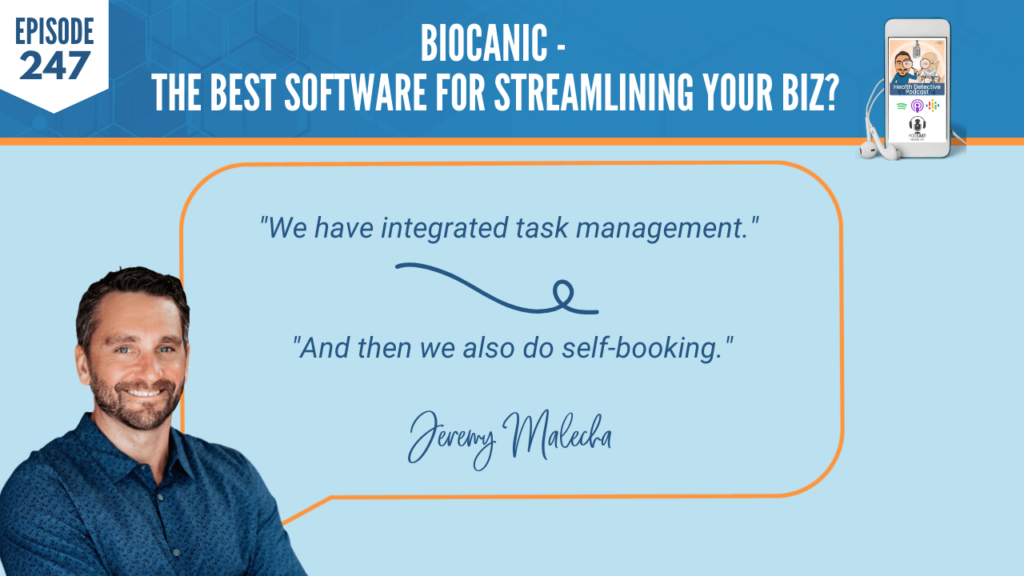
[00:34:12] Jeremy Malecha: We do other things. So, we have integrated task management, so you don’t have to pay for a Trello or Asana. That’s built into the system as well; I forgot to mention. And then we also do self-booking, so you don’t have to have a Calendly or a ScheduleOnce subscription as well. So, we can really simplify everything into a single experience for practitioners.
[00:34:30] Detective Ev: I was actually going to say the Calendly thing specifically because I was like, all right, $35 and I get the calendar software while I’m already paying, whatever I’m paying, I couldn’t even tell you, $12, $15 a month definitely for Calendly, just that alone, it’s like $20 extra, unlimited clients and I get all that other stuff. It’s kind of, in my opinion, a no-brainer.
I have two final questions for you. One is, it’s kind of a fun one, and you might have already mentioned these things, but again, God only knows how much like secret cool stuff you guys actually have in these softwares, knowing you and Jenn and probably how you guys work together.
So, what are your top two or three favorite features that Biocanic offers? It could be at any tier, but I’m just curious what your favorite ones are.
[00:35:09] Jeremy Malecha: Yeah, I mean as a data junkie biohacker, it’s the automatic lab data processing. That’s kind of our big bread and butter differentiation. We support over 150 different specialty labs.
People ask us how we did it. We’re like one at a time. And we’ve done it one at a time for the last four years since we started doing lab data processing. That is the most fun thing.
Biocanic: Implementing Customer Requests
It’s also really kind of delightful when somebody says, hey, I use this lab that’s not in there. Can you do it? Then we implement it in a couple days. That’s been a lot of fun to see the growth of all of the different specialty labs in all of the different approaches that we use.
The other side is, then being able to trend that in the summary report, being able to create that kind of professional follow up report in 30 seconds is like earth shattering, especially for a lot of the MDs that we’re used to working with now. They’re used to doing like charting in a hospital EMR, and they’re like, this is so much faster.
If anybody’s followed the EMR industry, everybody hates their EMR. And they’re like, oh my God, this is so much easier. So, that’s been a huge delight and an affirmation.
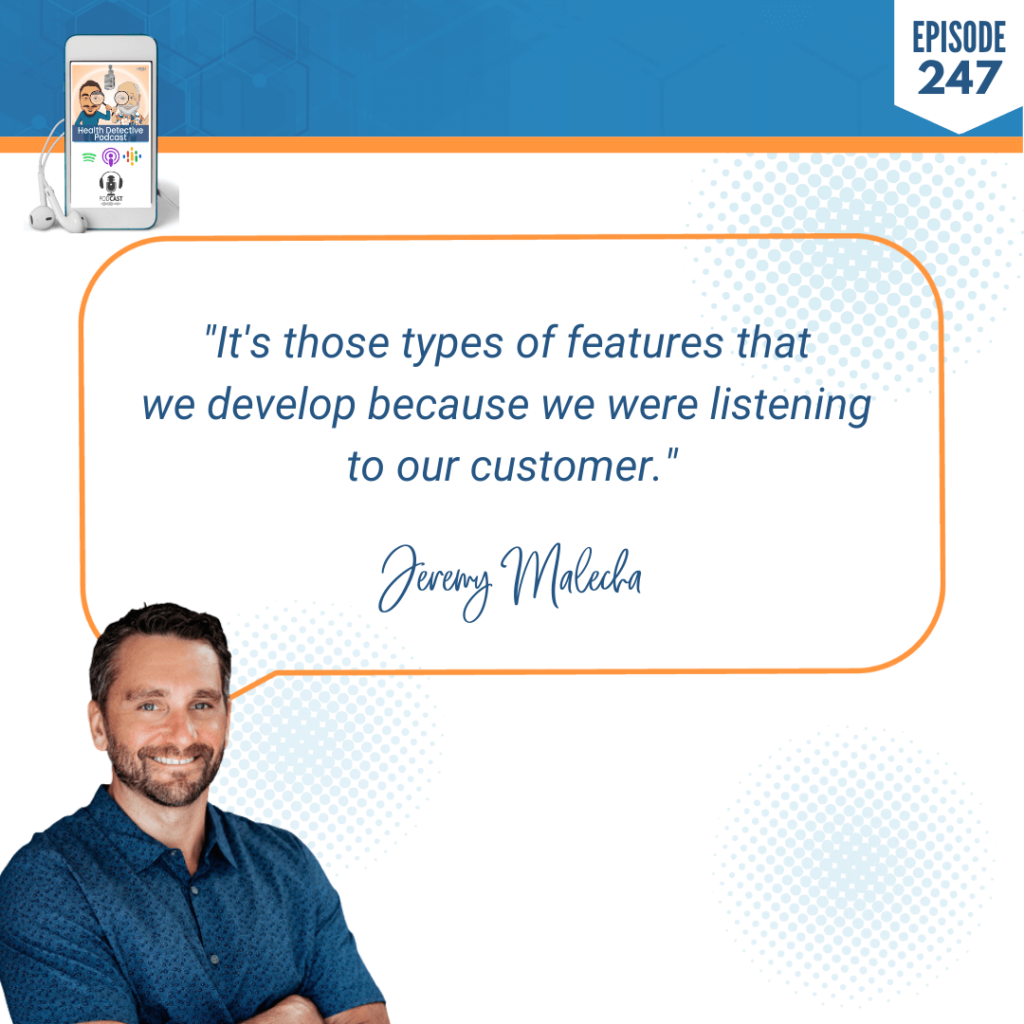
But you know, it’s those types of features that we develop because we were listening to our customer. That summary report that I showed you was based upon a physician talking about how every night she had to do her charting. She had her Google templates that she would copy and paste. And then she would have to go to the metabolic scorecard and copy and paste the scores or hand enter the scores, right? It was very time consuming. And just to turn that on its head so quickly was just so much fun.
[00:36:45] Detective Ev: I know that this is off the top of your head, but you’ve seen both sides, I guess for someone like Jenn. And she just, again, will continue to squeeze the optimization side.
Biocanic: For More than FDNs
So, let’s say I’m an FDN practitioner that has 10 clients and I’m not using any of these softwares. Like, I don’t do Biocanic, Practice Better or anything like that. I’ve just been doing maybe the Excel spreadsheets and kind of my own version of it. How much time do you think someone is saving by using something like Biocanic versus just working with those 10 clients and not using a software like this?
[00:37:13] Jeremy Malecha: I mean, we estimated that they’re saving about 60% of the time.
We actually have a slide where we actually add stuff up. The challenge is when you actually sum up all the time it takes, we estimate it takes about six to eight hours to get started with somebody after you’ve received the lab. So, call it their initial, follow up results review, that’s six to eight hours per individual, right? And we think we can shave at least 60% off of that. People are like, wait, six to eight hours.
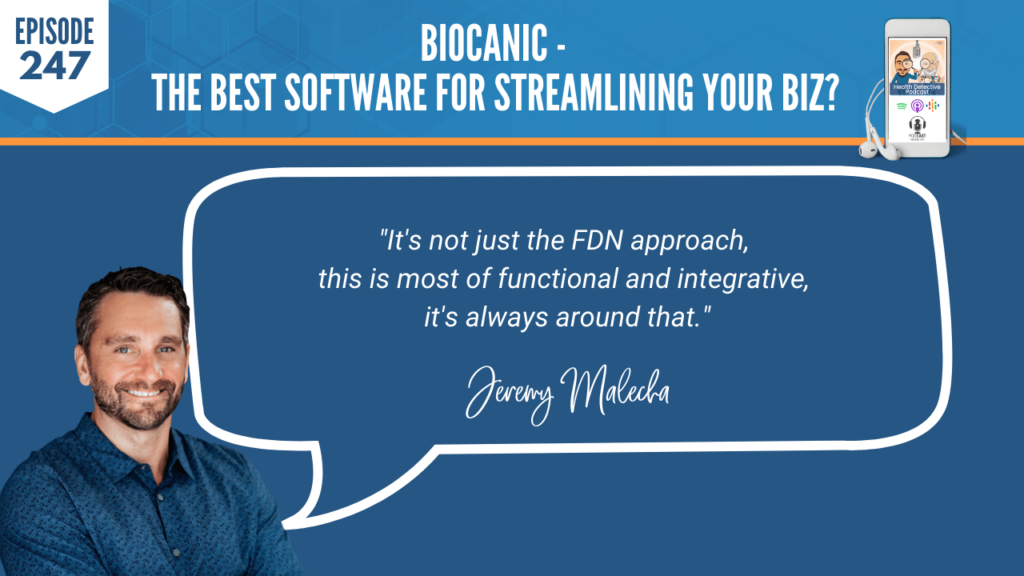
But then you’re like, okay, wait. I had to assign the intake forms, go order the labs, get the labs, upload the labs, look at the labs, and then I wasn’t ready. When you actually sum it up, it does end up actually pretty consistent. It’s not just the FDN approach, this is most of functional and integrative, it’s always around that.
Being able to save that on boarding time, just through being able to order the labs through us, being able to make the recommendations through us, that is a huge time savings. And if you think about six to eight hours, five new clients a week would be 40 hours a week. But you also have all of your clients that you’re working with.
Biocanic: Avoid Getting Bogged Down
So, as I was kind of alluding to earlier, you can’t scale if you’re spending that much time getting started with new clients because you still have to service your existing clients on whatever package they’re on. That’s why we’re so hyper-focused on efficiency and simplifying and bringing things to light, so that people can scale and see more people and ultimately make more money, but also help more people overall.
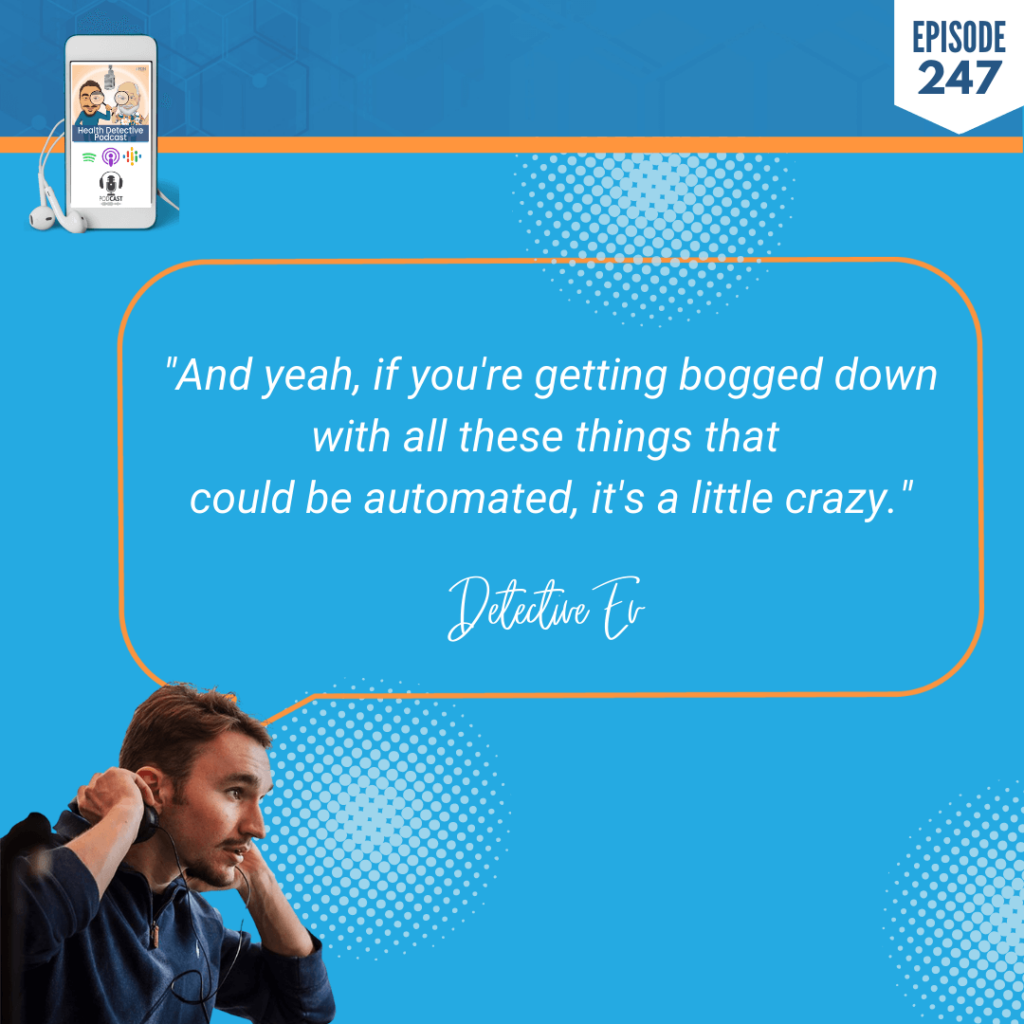
[00:38:40] Detective Ev: Right. What you just said at the end, get to help more people. They also just get to do what they actually love a lot more. Cause most of the people that go through something like FDN and think about it from a career side, their main interest is doing what we’re doing right now. They want to work with someone one-on-one, help them through their problems and things like that. And yeah, if you’re getting bogged down with all these things that could be automated, it’s a little crazy.
It’s not my business of course, to share like Jenn’s numbers, but I will just say, guys, Jenn does some insanely impressive numbers with clients and revenue. I guess you guys have to be right about the 60% in terms of time saving. You can’t be wrong. There’s no way that you could do the volume of clients that she’s done if it wasn’t optimizing everything else. And there’s more that goes into that cause Jenn, again, has programs that helps with some other sides of things.
But I think Biocanic would be a great place to start for people. I am a liar too cause I had two main questions, but now I have like my rapid-fire ones.
Where to Find Biocanic
[00:39:31] Jeremy Malecha: It’s one thing to bring it to life for any trainee or graduate. How long does it take you to fill out the FDN case notes report form?
[00:39:39] Detective Ev: Well, even from a medical director program standpoint, that sucks. That’s why I think they did away with it because people weren’t doing it cause it took so much time. So yeah, a good chunk.
[00:39:47] Jeremy Malecha: Right. And if you could do that in five clicks instead of going to each section and copying and opening the document, that is exactly the pain point that we solve. That’s where the efficiency comes in and usually helps people really understand it.
[00:40:00] Detective Ev: Nice. All right. So, my rapid-fire questions, just thinking like from the audience perspective and now they’re interested in this, maybe having these questions go through their head.
One they’re going to be wondering is, where can I find this? Can I try it? Do they have to buy it right away? What would that look like for them?

[00:40:14] Jeremy Malecha: So, we’re Biocanic.com. There’s a button that says FREE TRIAL. So, we have a two week trial and we do onboarding training. We have a community site, very open book about our features and functionality. We’re always happy to get on a demo, answer any questions, walk you through everything. So, going to our site is the best starting point.
If you want to see kind of how the features and everything and the content we deliver, we have our community site, which is hix.biocanic.com. You can see how we’ve kind of evolved the system over time.
Biocanic: Customer Service Support
And also, there’s additional educational content. We highlight other practitioners’ approaches. So, if you’re thinking beyond FDN, hey, I want to niche into integrative dermatology, we do a lot of interviews like Dr. Julie Greenberg, who’s a really well-known integrative derm as an example.
But yeah, two-week trial, and you can stop and start. There are no long-term contracts. Hey, you want to try it out? You’re not ready. You know, you’re going on vacation, you’re going to restart. We’re very flexible when it comes to working with us.
[00:41:11] Detective Ev: That’s totally fair. Awesome!
You actually answered one of my next questions, which was about the training. Actually, it’s a good problem to have, but there’s so much stuff that I can imagine it’s a little overwhelming in the beginning. So, you mentioned a demo, like are they actually talking to someone from the company?
[00:41:27] Jeremy Malecha: Yeah. We do one-on-one training, and our employees are FDNs. It’s not often that we promote that, but obviously they speak the language, they know the approach, and they’re very helpful cause they both worked with individual practitioners and their own clients as well.
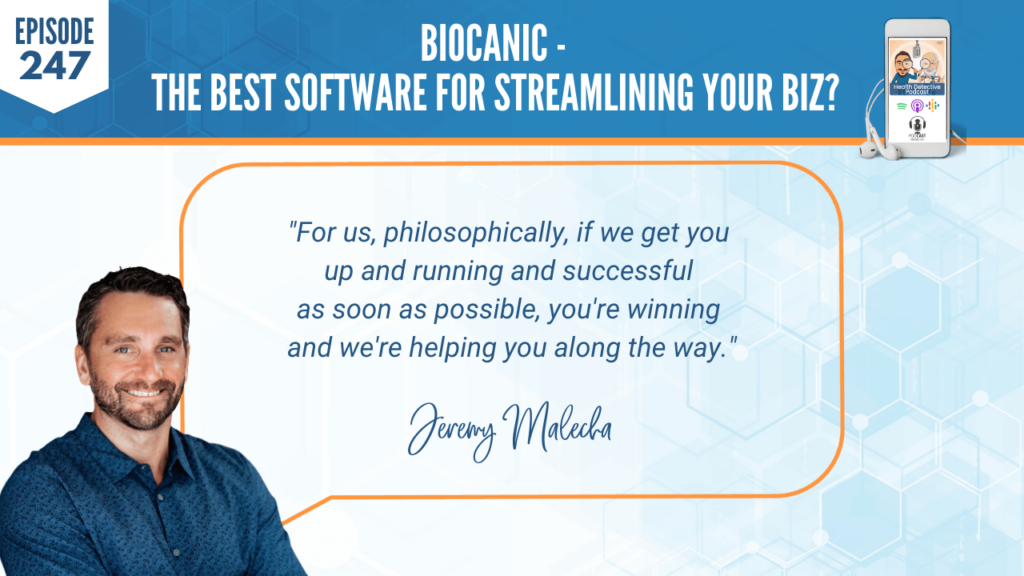
We are hands on with our practitioners. The worst thing about learning a new technology system is being directed to a blog link or a tech support site on a website and reading four pages when you just need an answer to a question. For us, philosophically, if we get you up and running and successful as soon as possible, you’re winning and we’re helping you along the way. It saves any back and forth and, you know, we didn’t answer the right question with the right link and everything.
Biocanic: Walking Customers Through
We also encourage people to reach out as they’re going. So, oftentimes, hey, I finally found time to sit down and get in this, and now I’m stuck somewhere and have a question. Send it right away. Don’t let things stack up. While you’re in the framework, in the learning framework, it’s best to get your questions answered at that time. That’s why we’re so hyper responsive to our questions that come in.
[00:42:29] Detective Ev: Very cool. I cannot agree with that more. I think that’s very wise of you guys.
I’m a young dude, man. You think I would know about computers and stuff. I spent so long recently, just in the last three weeks, we started using Kartra for my own personal stuff. And I really like the program. It’s amazing how easy it is to build the templates for your funnels and stuff.
But beside the point, I could not for the life of me easily figure out how to get the domain on there from GoDaddy. There was just like this whole extra process, it was a pain in the butt. I’m like, I’m young and I like to believe I’m half intelligent. And I’m having trouble figuring this out. I’m like, what about like the 60-year-old person that wants to build their first funnel or something? It just wasn’t user friendly at all.
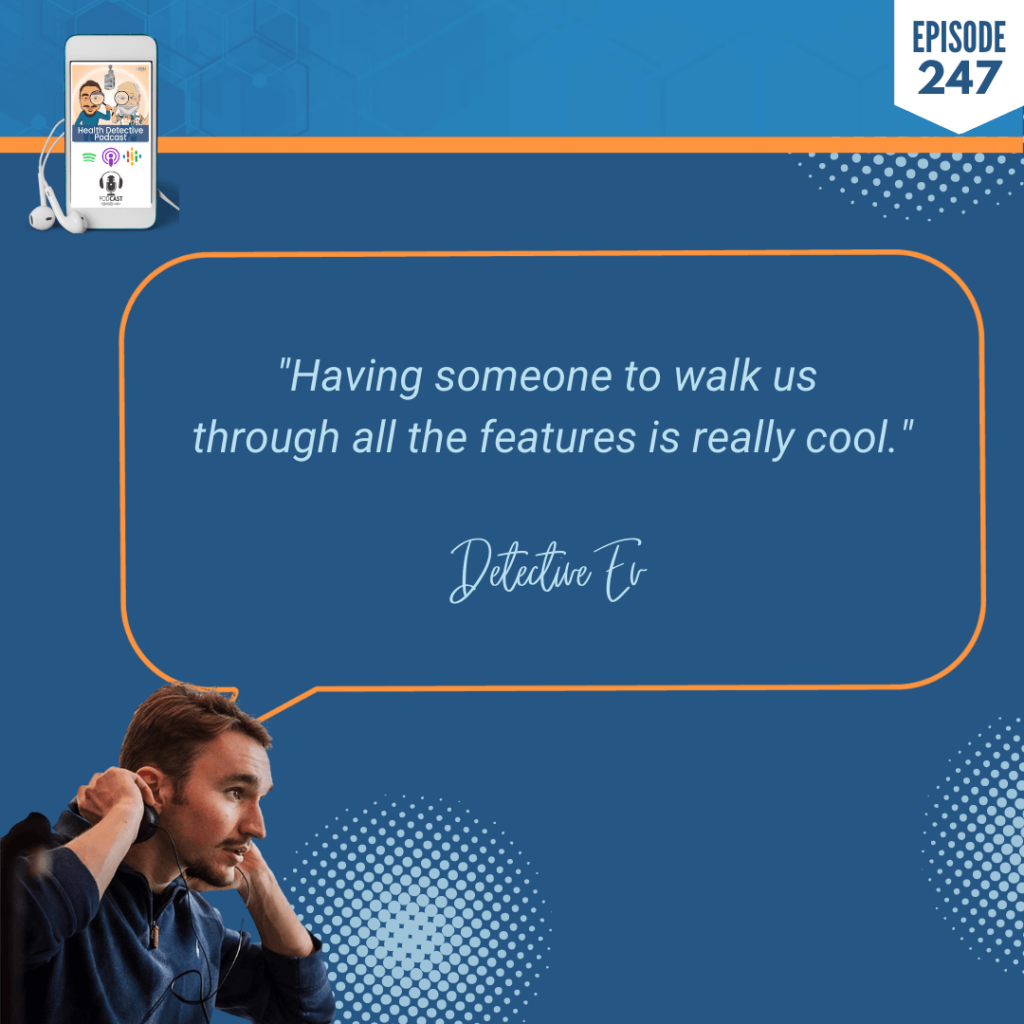
And then, my gosh, getting our leads in from our previous place to there has been a nightmare too. So, I love the fact that you guys are helping out with that because I do think all of us need it regardless of whether we’re older or younger. Having someone to walk us through all the features is really cool.
Biocanic: White Label Set Up
We talked about the educational side. That’s great. If I have custom intake forms, could I upload those to Biocanic?
[00:43:27] Jeremy Malecha: Yeah. It’s a form builder. That’s all created in there. If you’ve ever created a Google document, you can make it in our system.
We serve a wide range of functional and integrative, there is not an intake form I’ve seen that can’t be implemented in our system now. So, we have to do things like timeline tables, supplement medication tables for the intake process, skip logic scoring system. And we can also help you do that too, as a part of our onboarding process. It’s really easy once you get going.
[00:43:55] Detective Ev: Okay. And my real last rapid-fire question, I understand that some of these things, I could be wrong, but like there’s an ability to pay for a personalization of it, like, it can be on your own website. I don’t actually fully know how that works, so forgive my ignorance. But is there a way to personalize it with Biocanic or will people know that they’re using the third-party software? Not that that really matters, but I’m just curious.
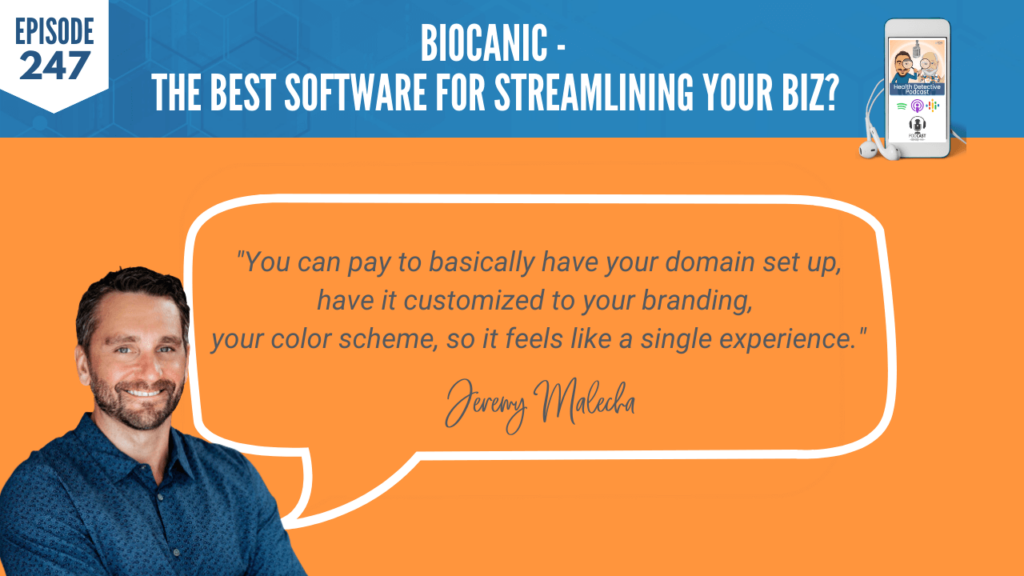
[00:44:18] Jeremy Malecha: Yeah. We do have what’s called a white label set up. You can pay to basically have your domain set up, have it customized to your branding, your color scheme, so it feels like a single experience. It basically removes all the Biocanic branding.
That is just a one-time, $1,000 setup fee. And once it’s set up, you actually have administrator controls. So, if you do change your brand over time, you can fully change that at a later date as well. It’s just the initiation and creation of the individual website.
Conclusion
[00:44:46] Detective Ev: That’s awesome. You guys got everything. Is there anything that I missed today that you wanted to make sure we got out because I’ll still talk about some of the things I loved when I record the intro. But anything we missed?
[00:44:56] Jeremy Malecha: No. I mean, we’re always looking for our features and functionality come from our practitioners, so if there isn’t something that we’re doing today that you’d like to see us do, let us know.
I know that there’s quite a few FDNs that knew us all the way back in the 2018 first FDN conference where we demoed a prototype, and we didn’t even have software. It’s been evolving and we continuously bring out new features of functionality every couple weeks. So, just cause you don’t see it in there today doesn’t mean we can’t get it out tomorrow. And that’s how we really grow and continue to iterate, really bring value to this particular industry. That’s our focus.
[00:45:31] Detective Ev: Cool. Hey Jeremy, man, it’s really nice getting to actually talk to you for once. Thank you for creating this. And I will let the audience know how it goes on our end because I’m about to get Maddy signed up for the free two-week trial.
[00:45:41] Jeremy Malecha: Awesome. Sounds great.
You can always visit us at functionaldiagnosticnutrition.com. Our Instagram handle is @fdntraining.
For more informational and functional health-oriented podcasts like this one, go to functionaldiagnosticnutrition.com/health-detective-podcast/.
To learn more about us, go to functionaldiagnosticnutrition.com/about-fdn-functional-testing/.

